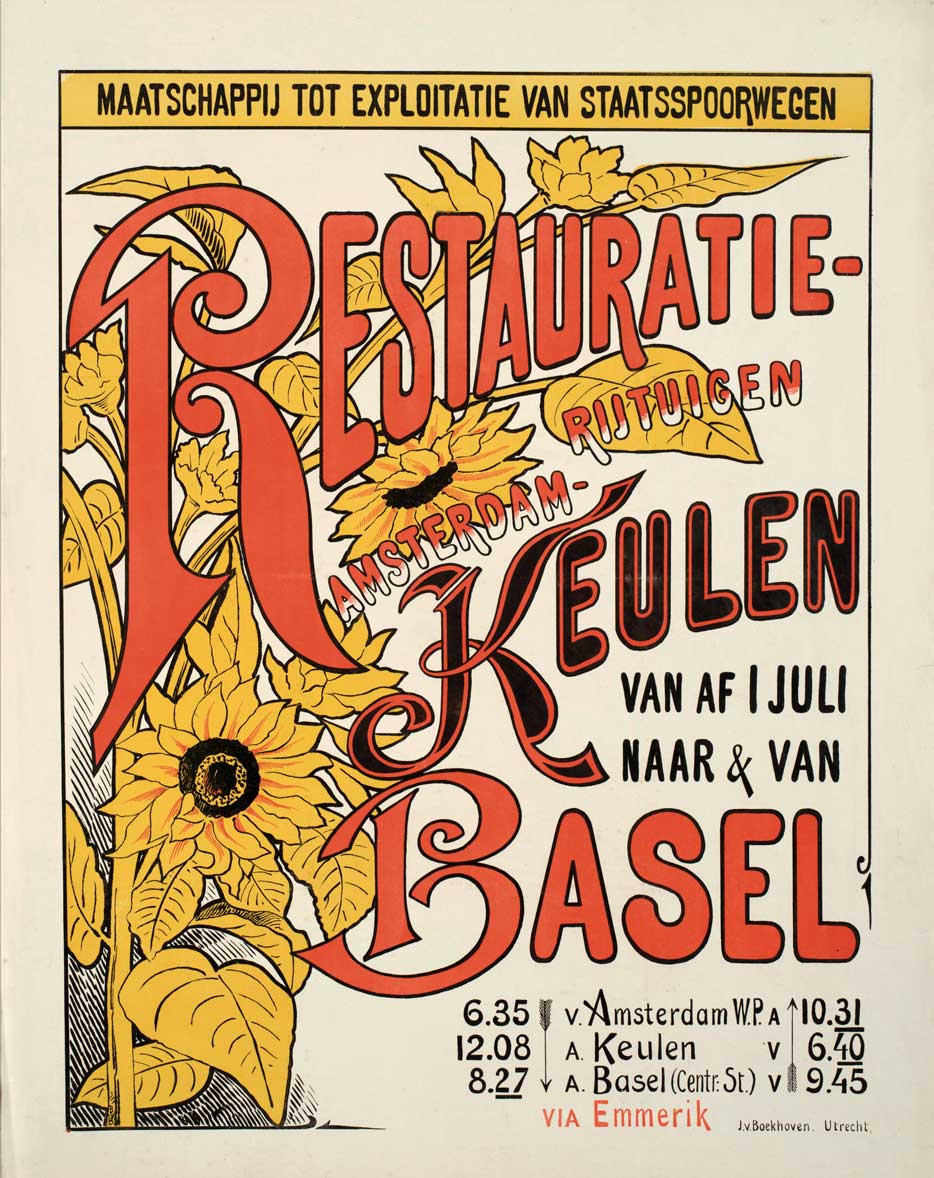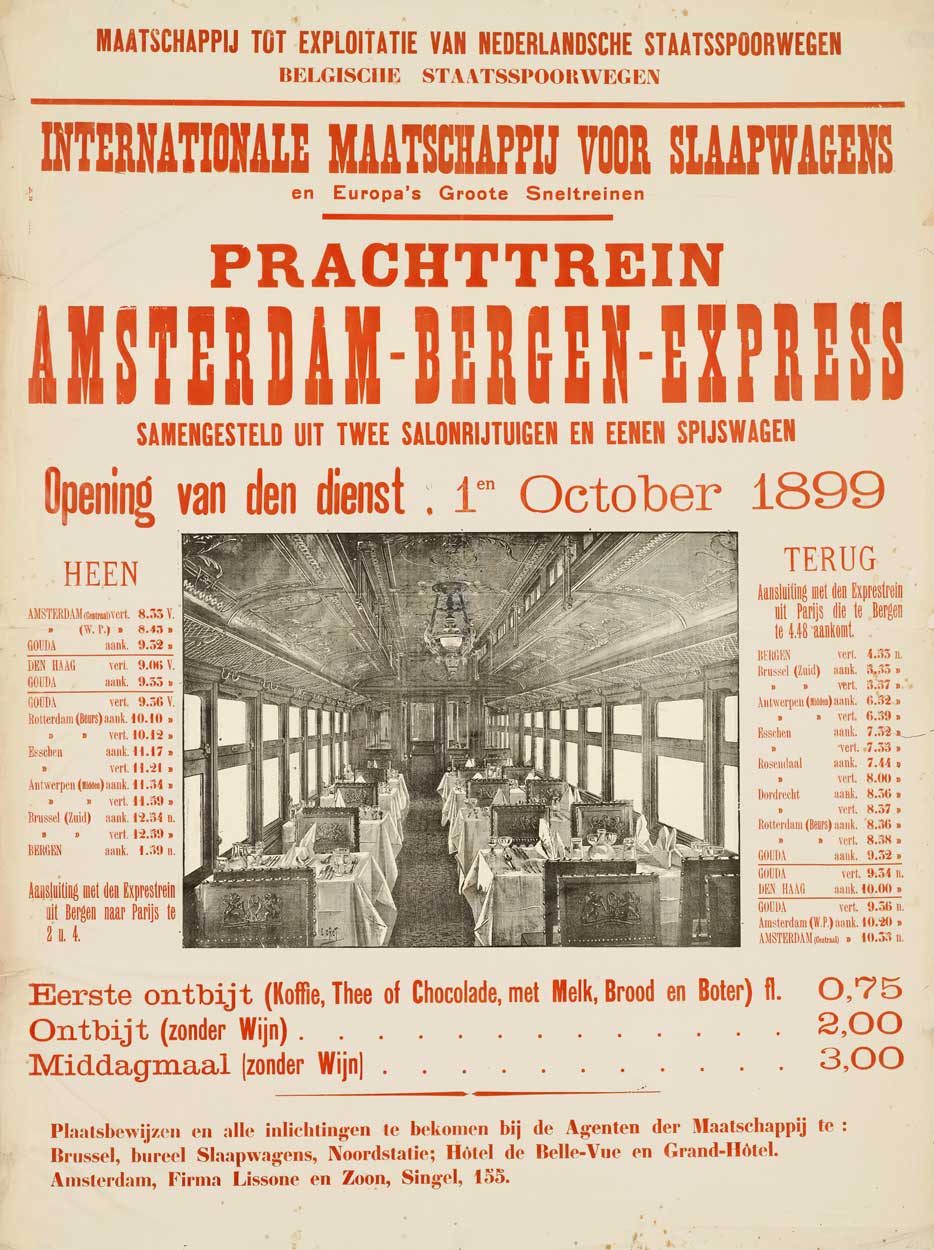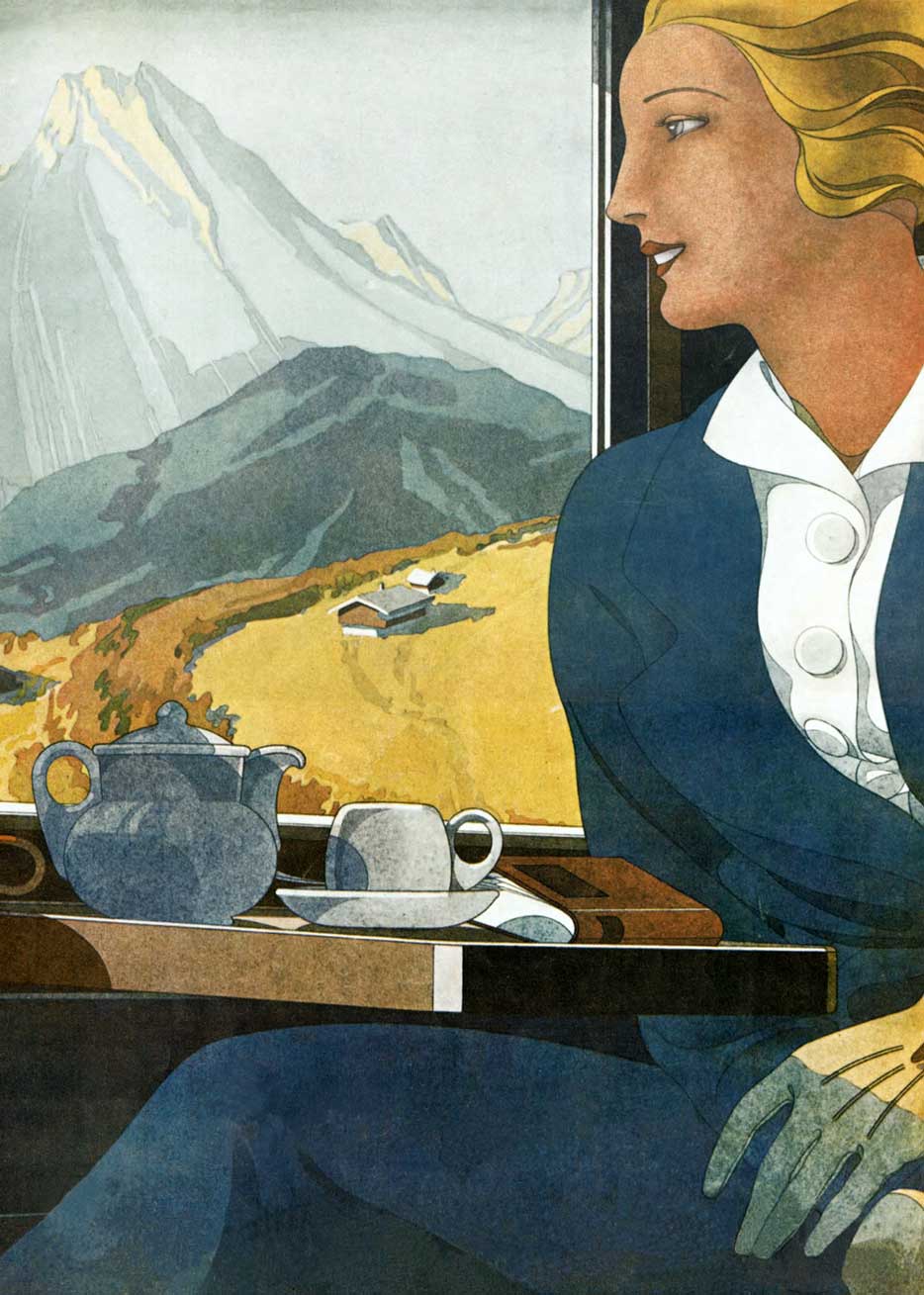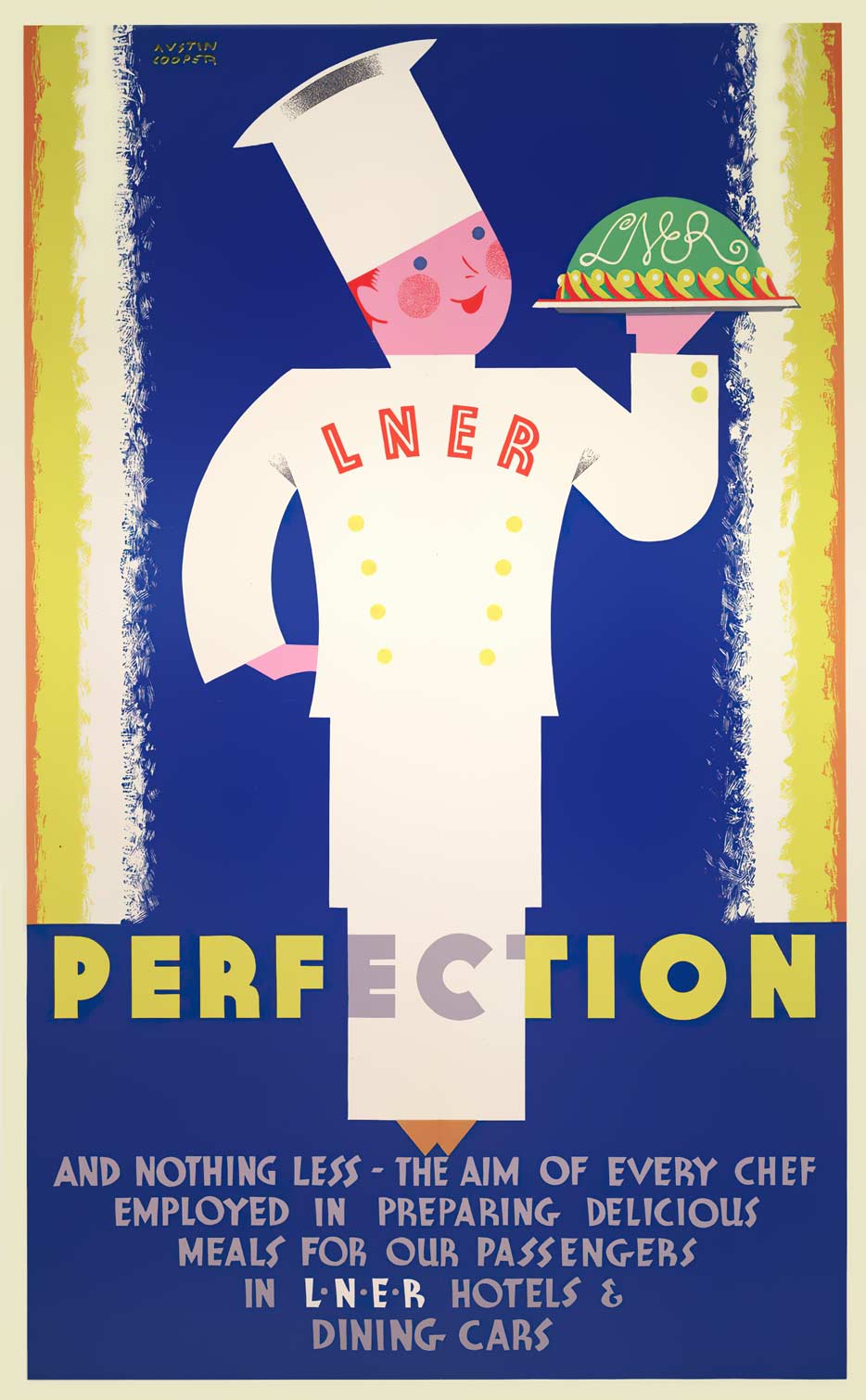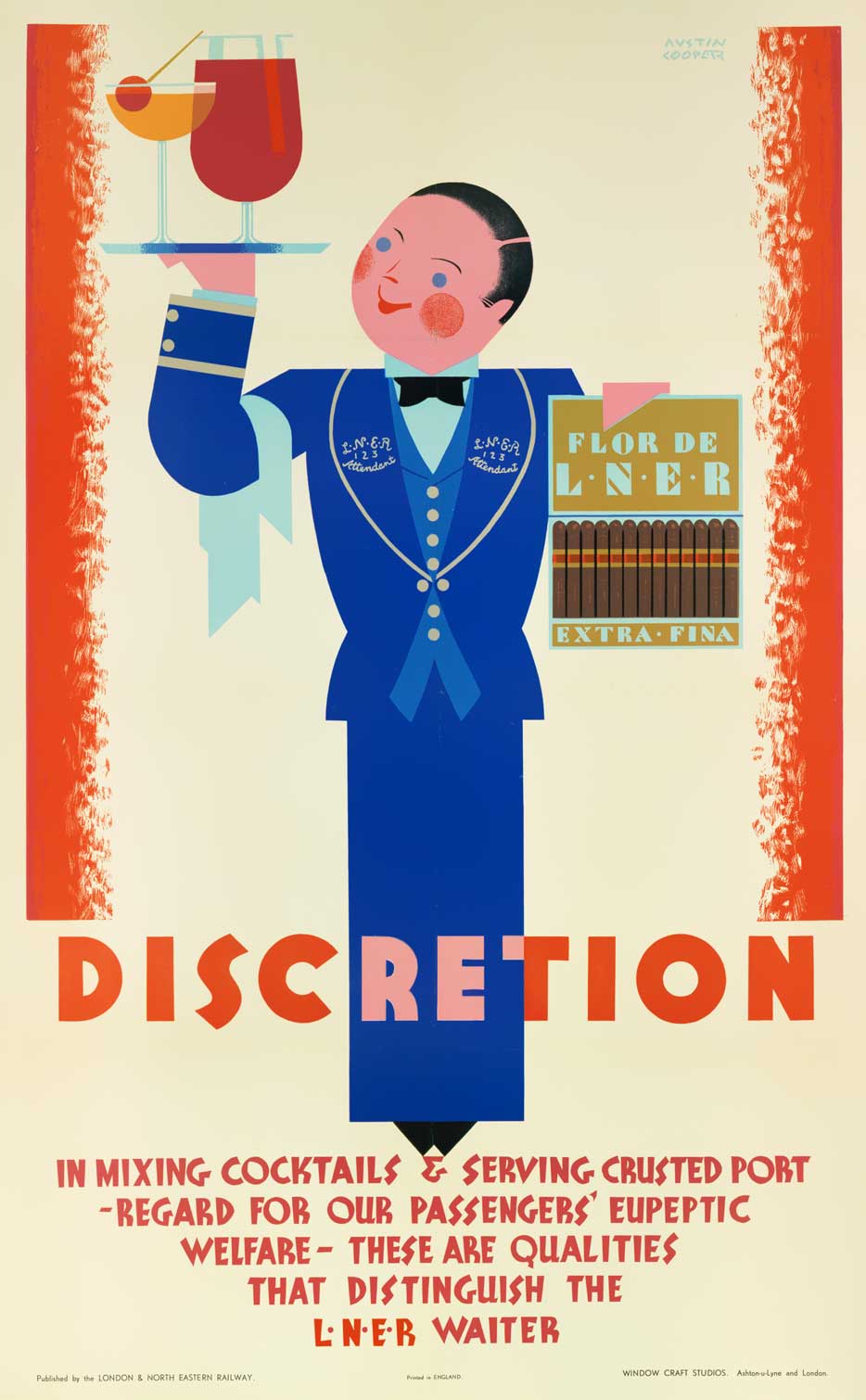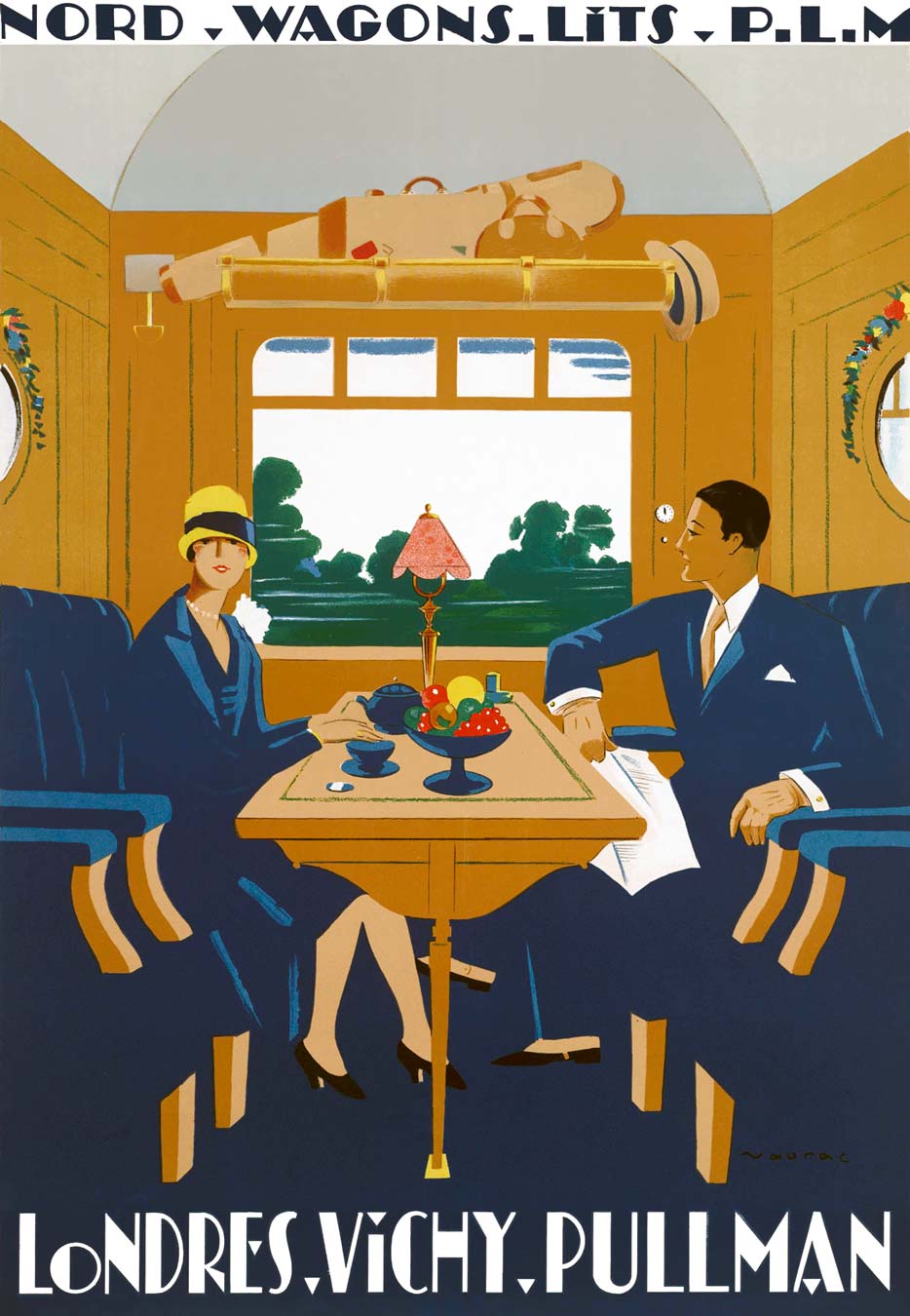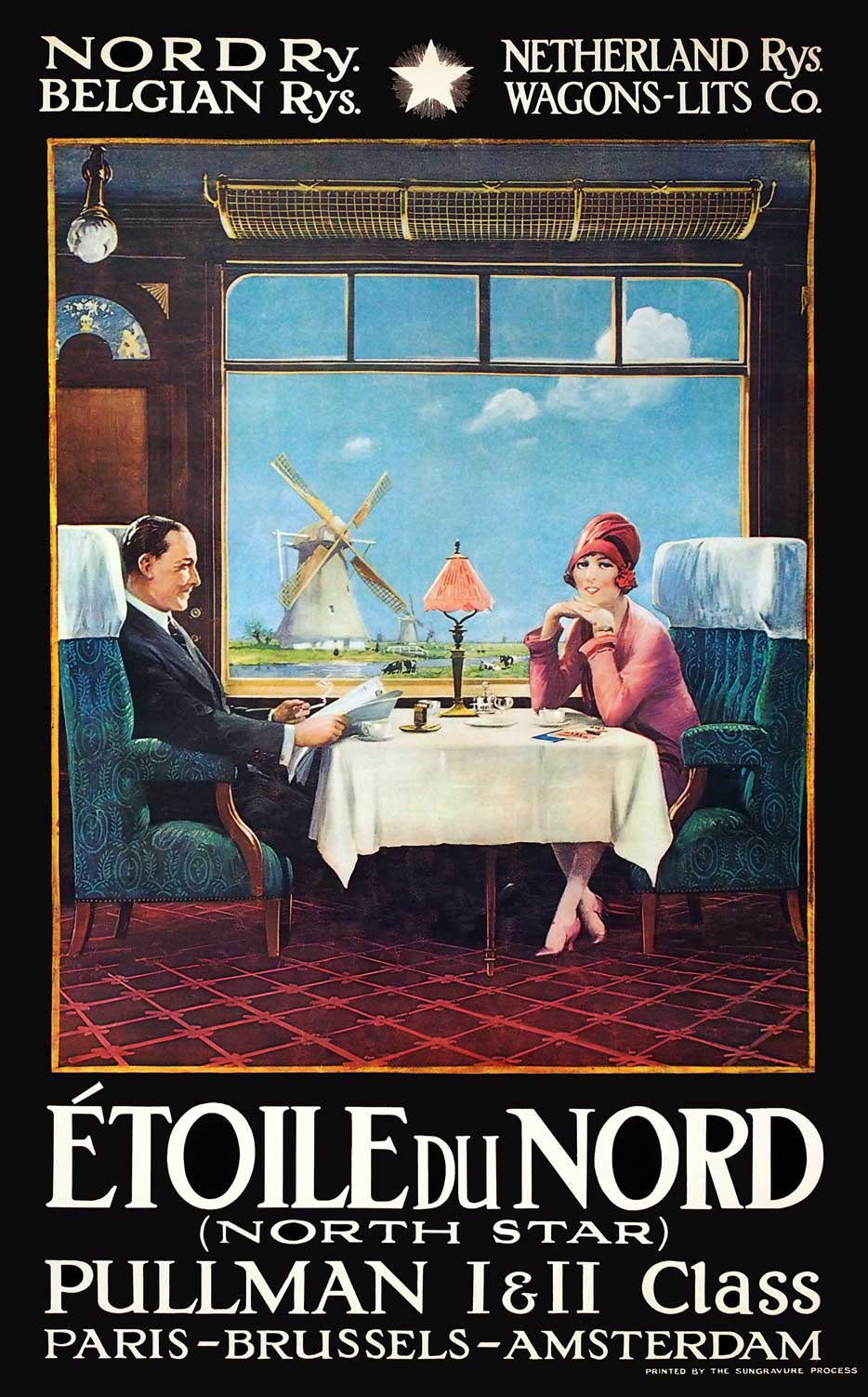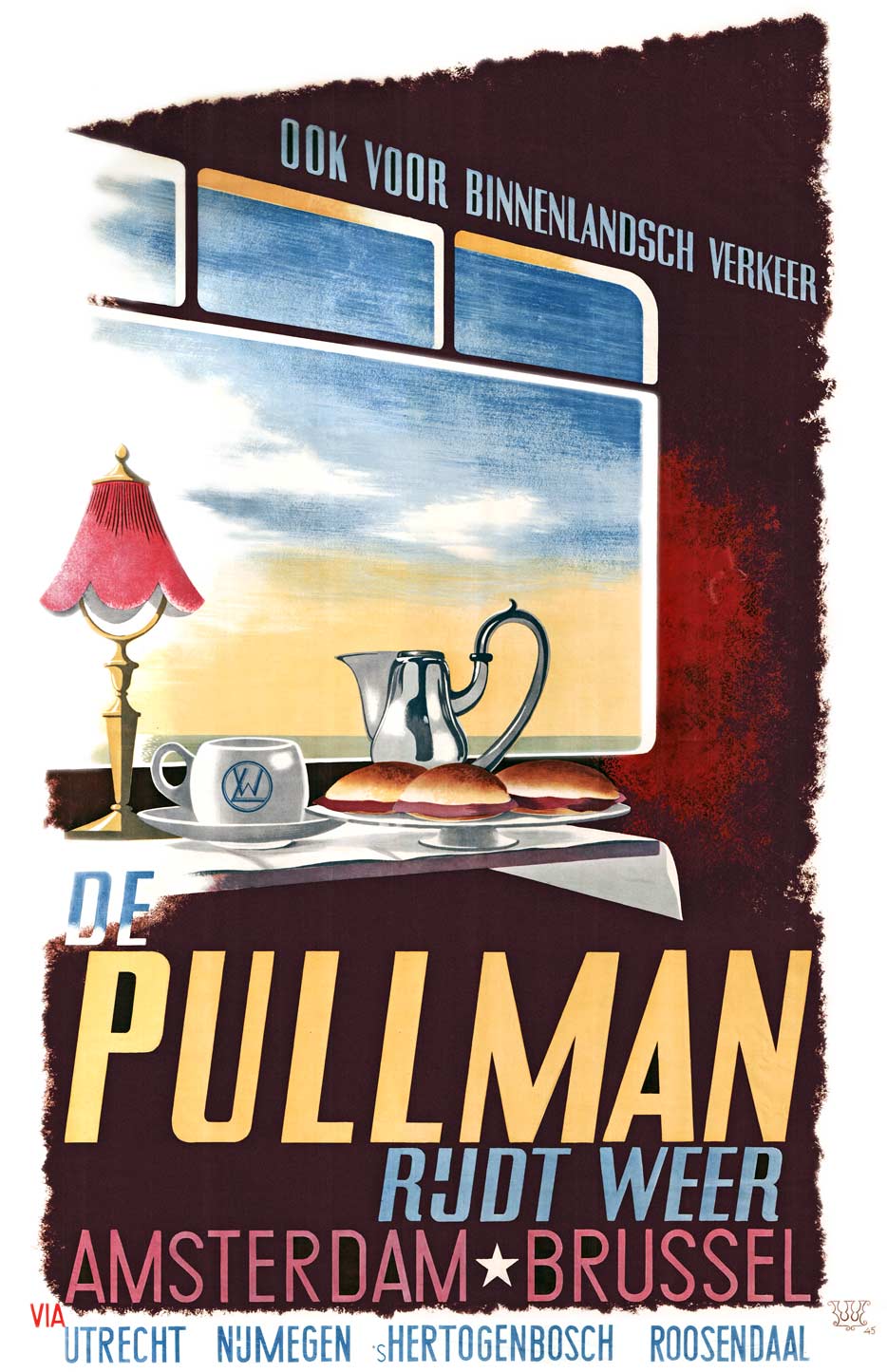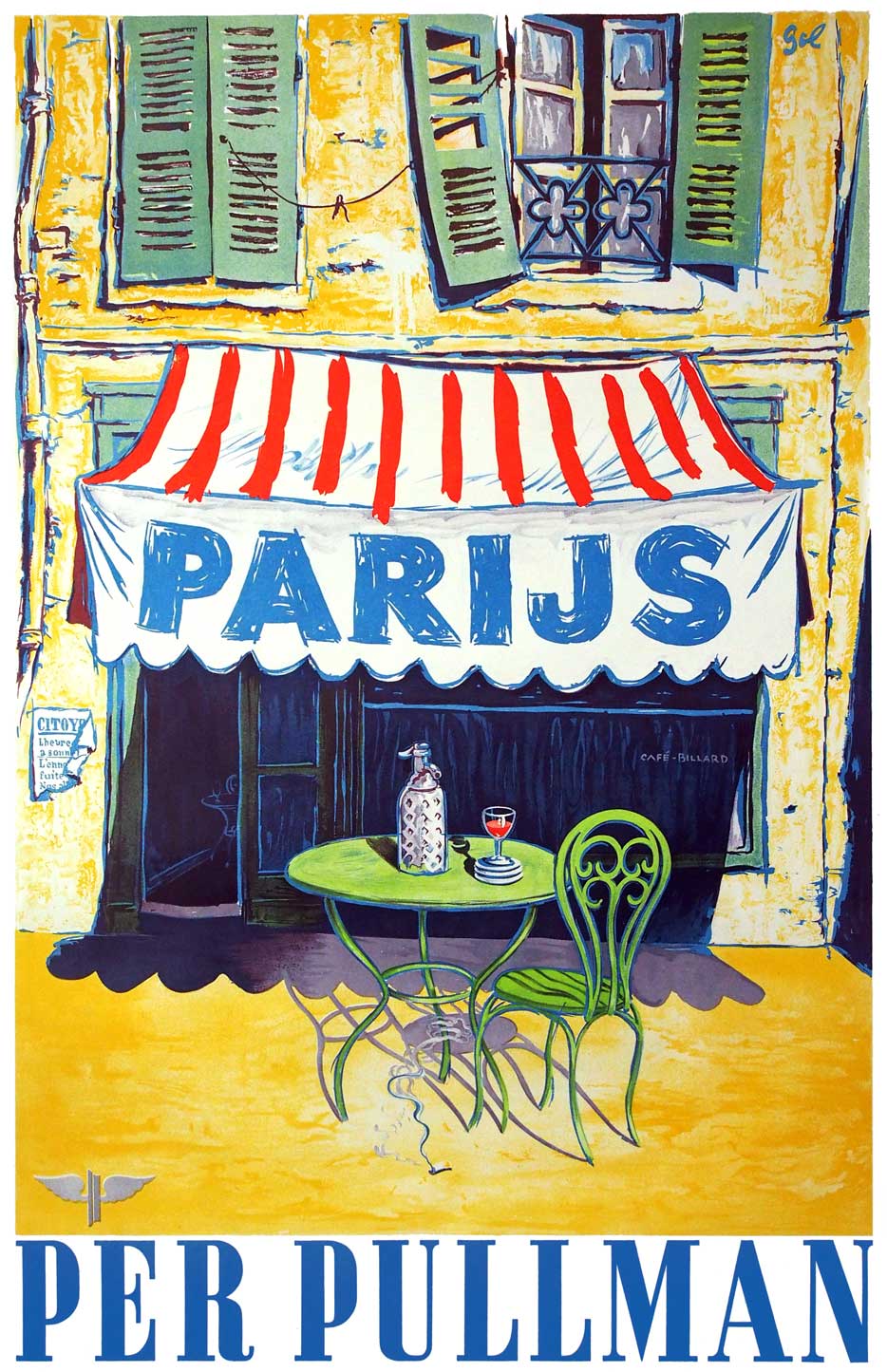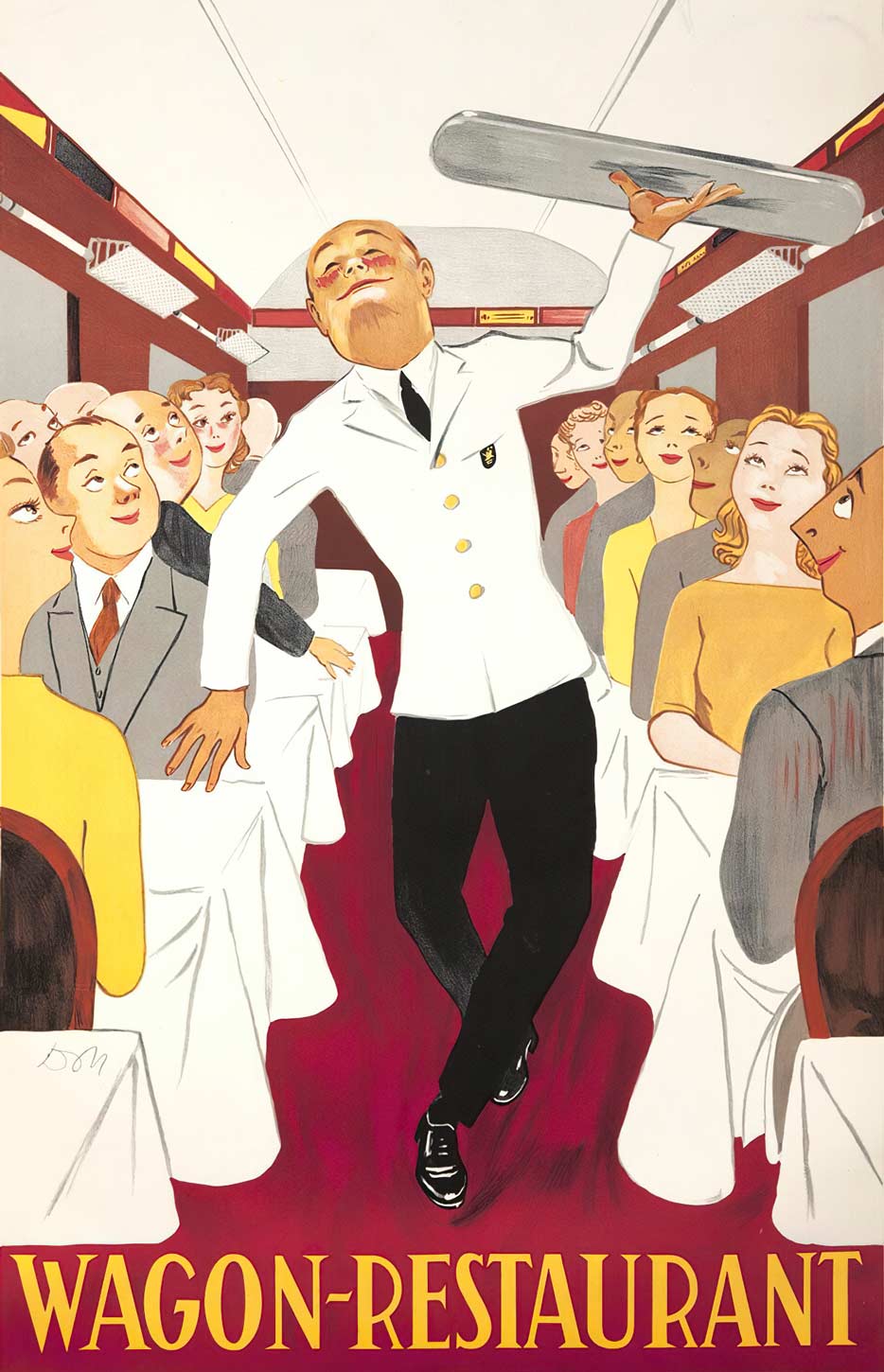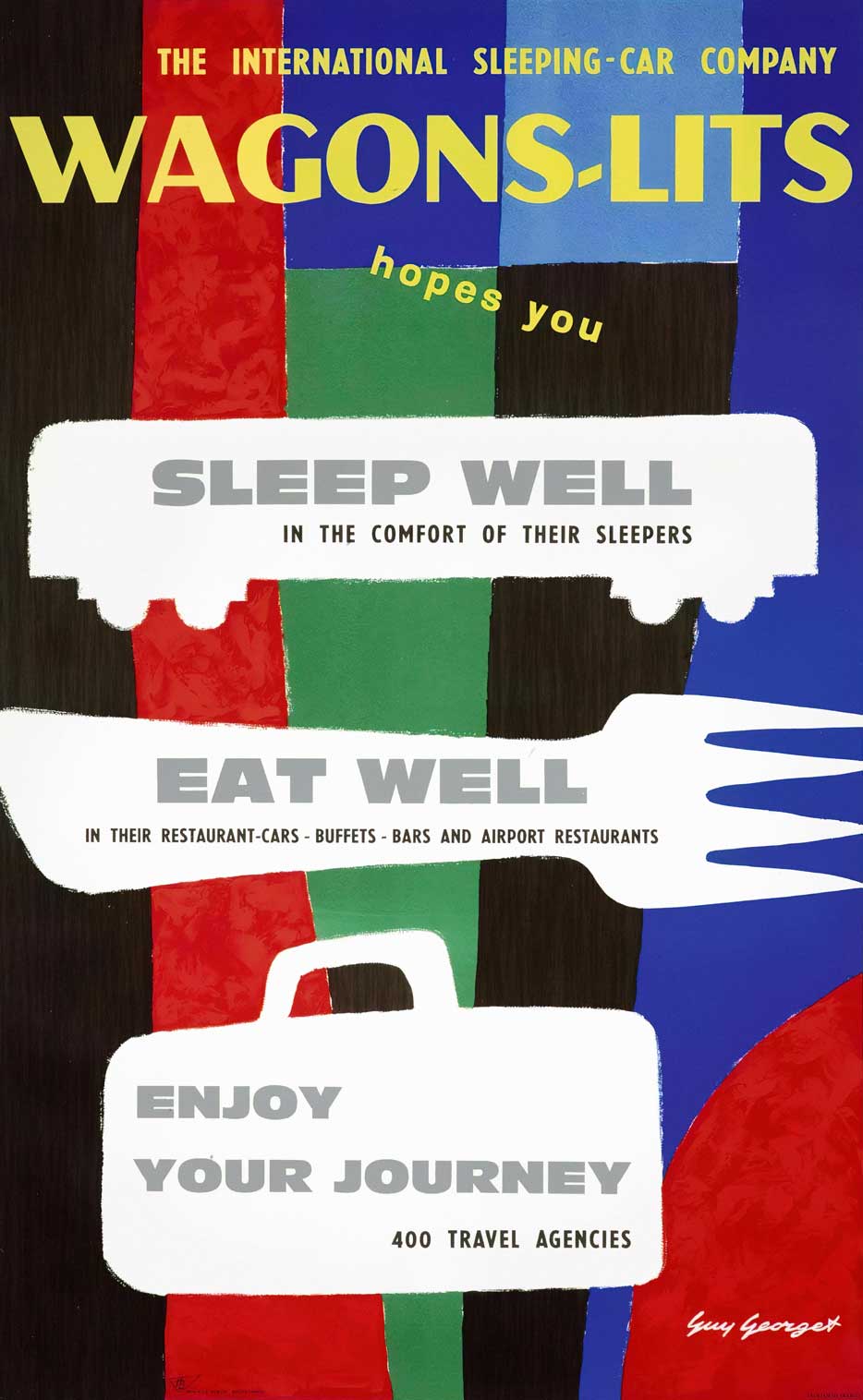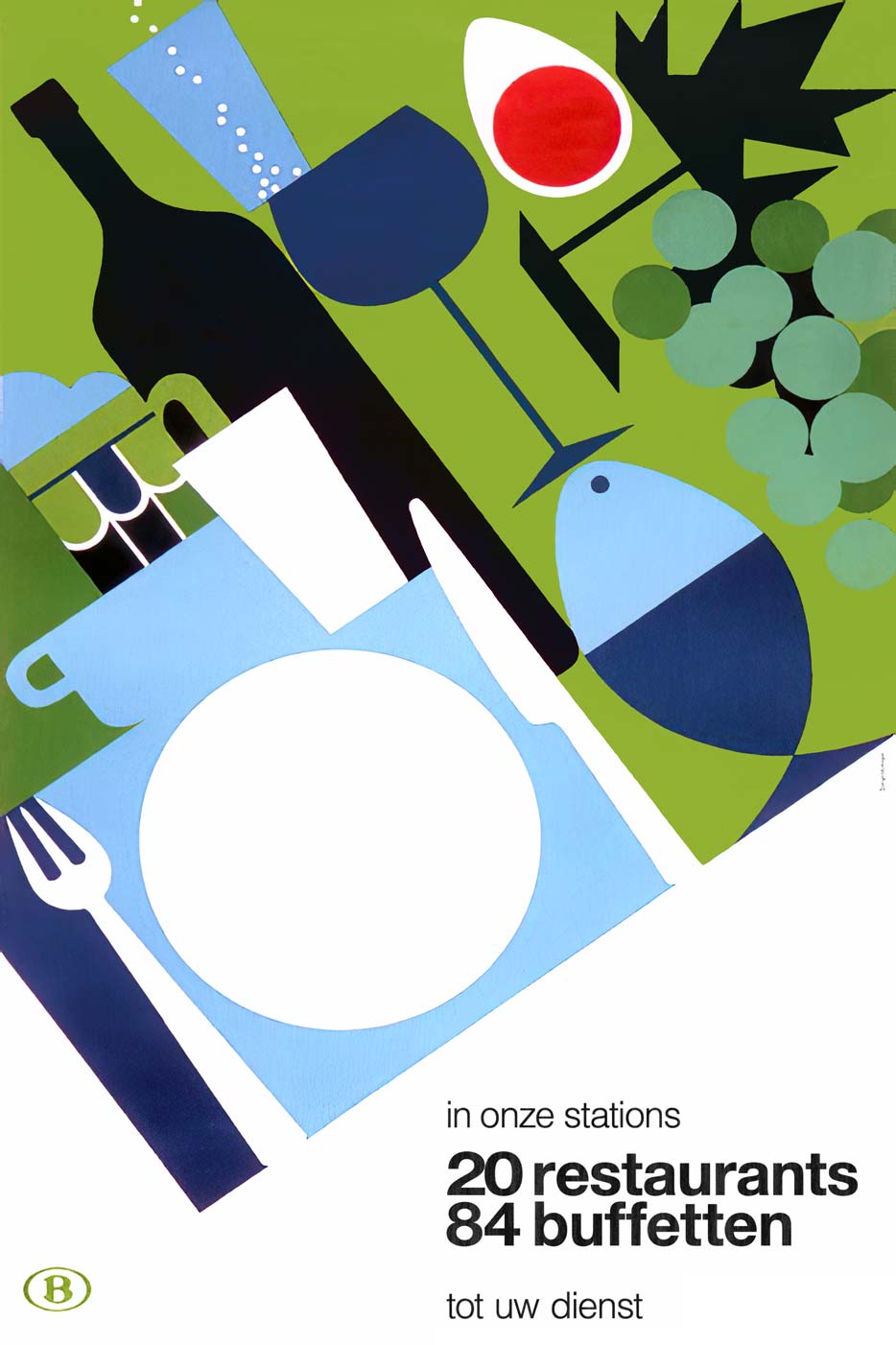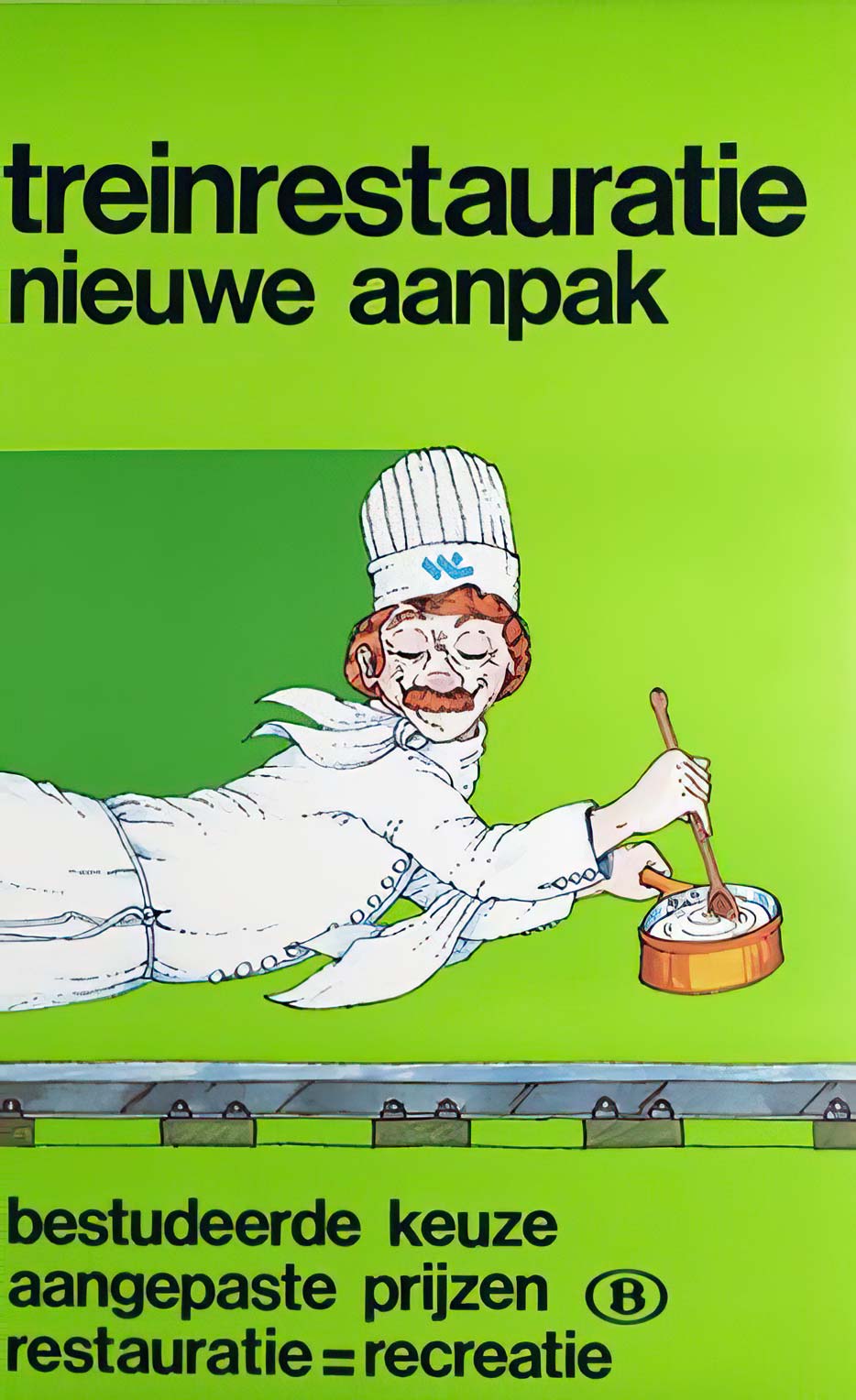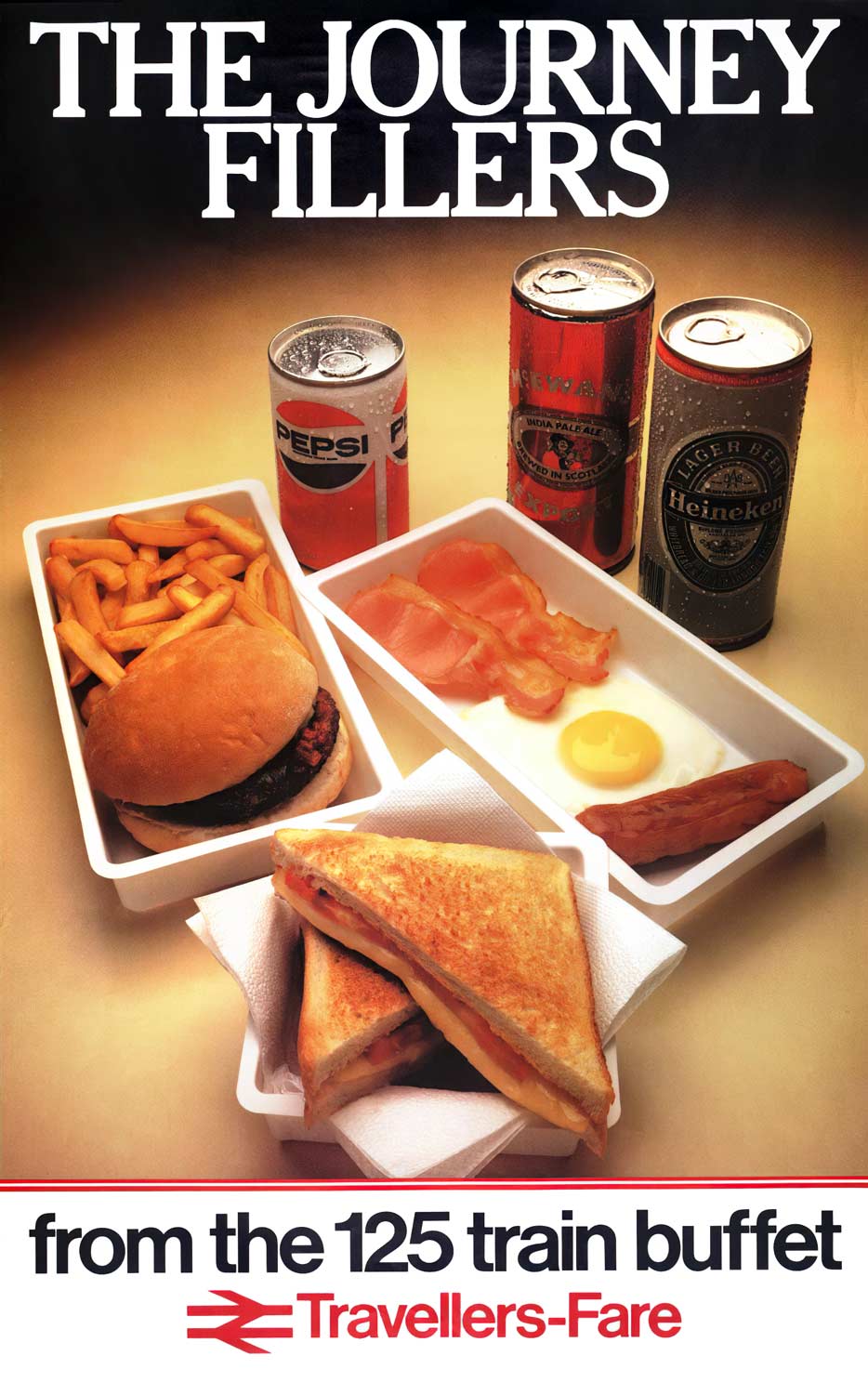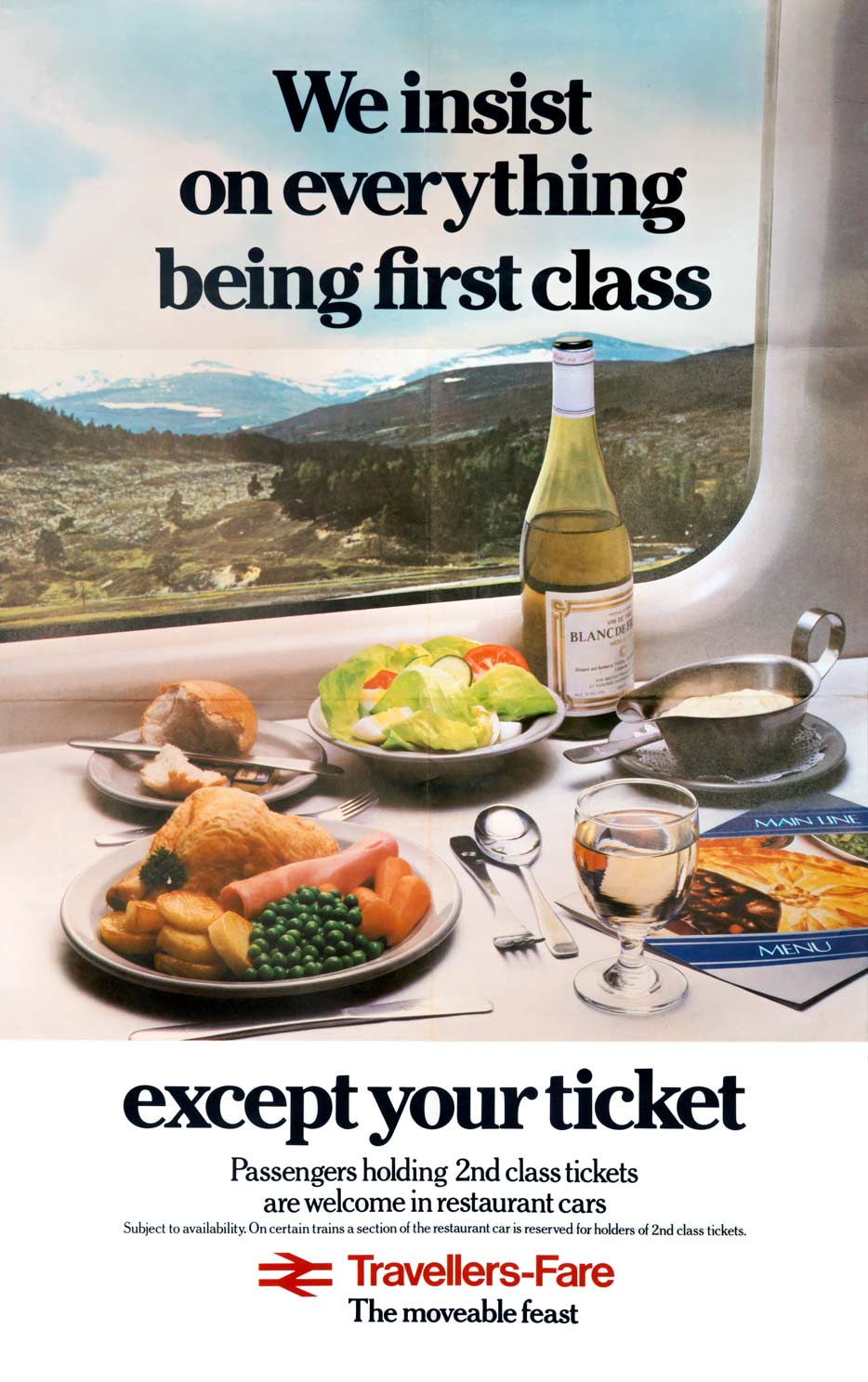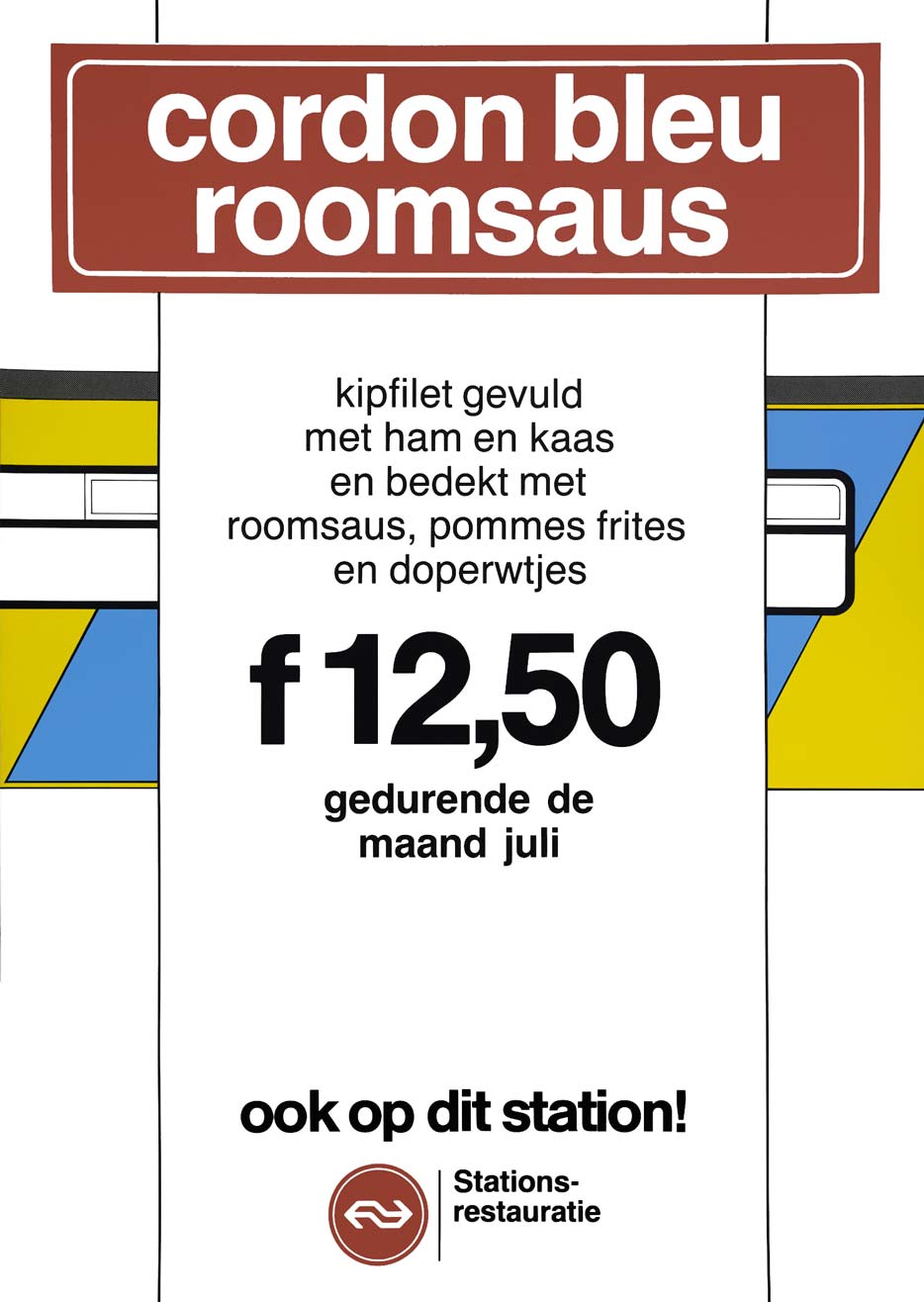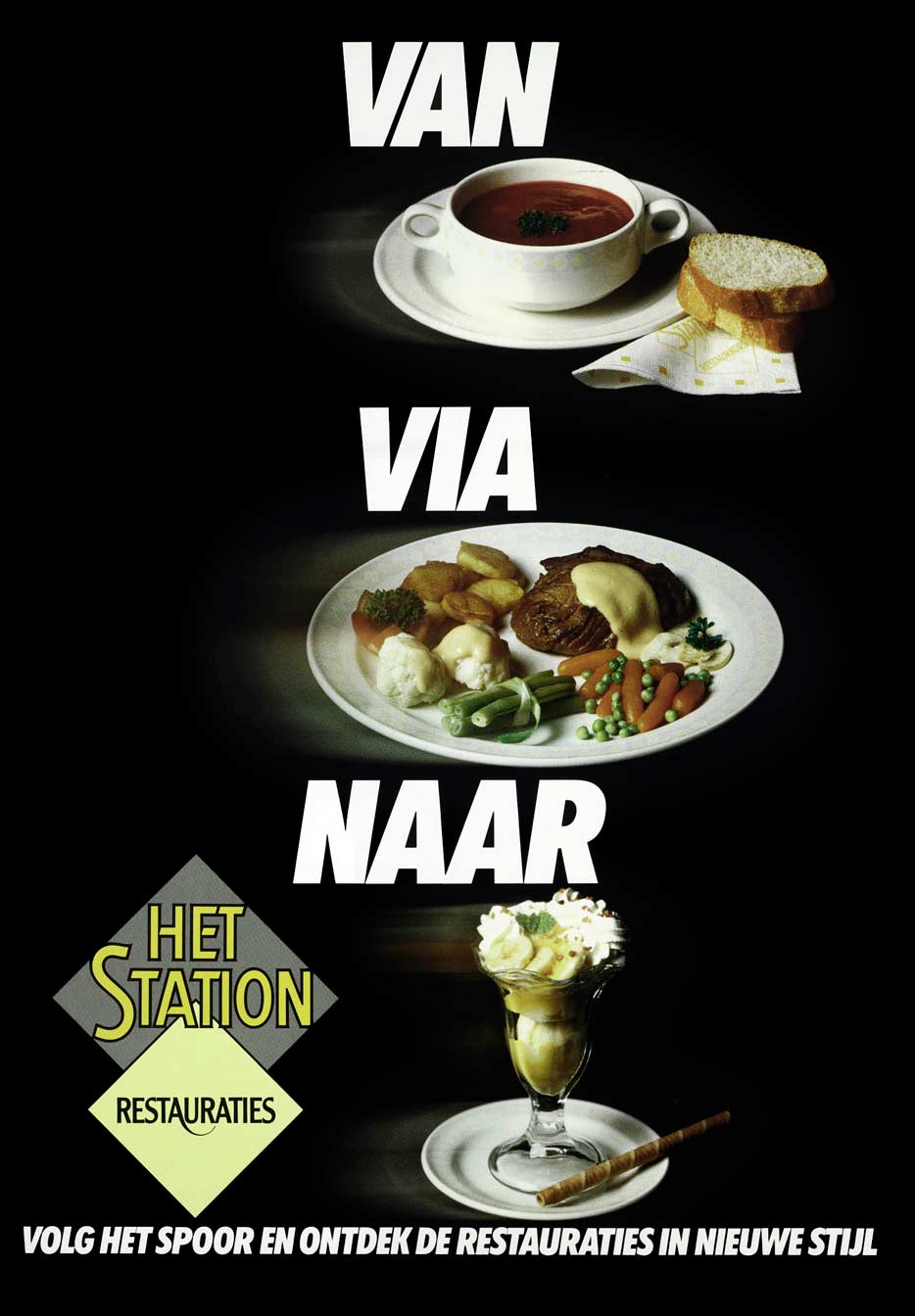Restaurez-vous
Dining and drinking at the railways
 Nederlandse versie
Nederlandse versie
An exhibition at the Dutch Railway Museum in Utrecht, titled Toasties Truffles Trains, tells about food and drink in trains and stations. It features real dining cars from several countries. Inspired by this exhibition, RETOURS showcases over thirty culinary railway posters from all over Western Europe. The posters, covering the whole of the 20th century, show that what you were served strongly depended on the period and price class.
Luxury trains offered lavish multi-course dinners and fashionable cocktails were mixed in special bar cars. French station buffets served traditional regional dishes, while 'rolling snack bars' originated from the same country. In the United Kingdom, British Rail sandwiches had a questionable reputation, just like the 'Honki Tonki' burgers in Dutch station restaurants.
Wagons-Lits
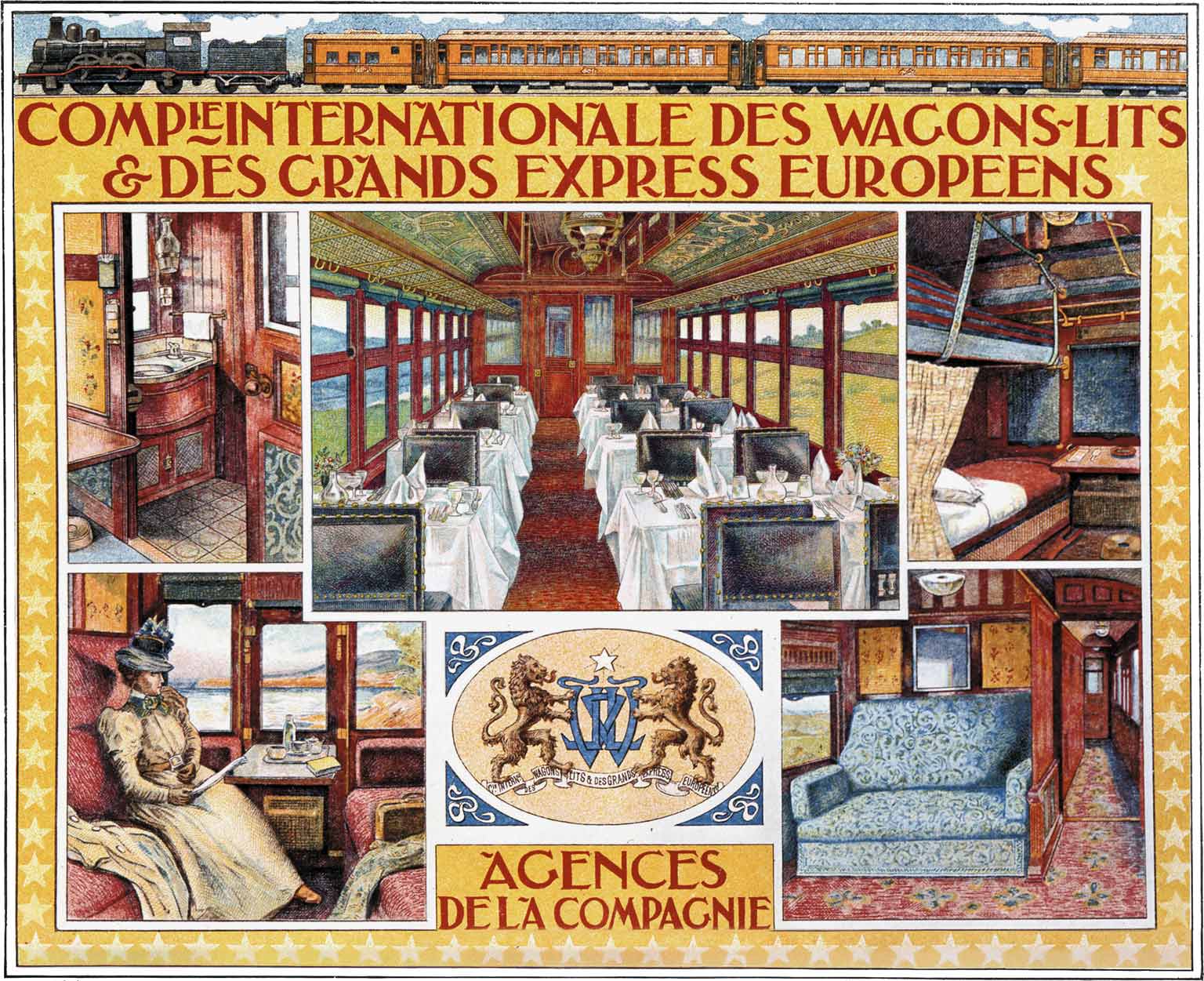
In 1865 American entrepreneur George Mortimer Pullman founded the Pullman Palace Car Company, which operated sleeping and dining cars on the extensive American railroads. Georges Nagelmackers, a young Belgian banker's son, traveled the US by Pullman train in 1868. He saw a gap in the European market. After several more and less successful experiments, Nagelmackers founded his Compagnie Internationale des Wagons-Lits in 1876, which operated sleeping cars in European trains.
In 1880 Wagons-Lits had an improvised dining car running between Berlin and Bebra. When this proved successful, Nagelmackers started the development of special dining cars. He signed agreements with railway companies to allow his carriages to run in existing train services. From 1883 onwards the company also provided special luxury trains, which consisted entirely of Wagons-Lits cars. The Orient Express was the first one, soon followed by the Calais-Mediterranée Express and Nord Express.
Prachttrein
In 1885 a Wagons-Lits dining car ran in a Dutch train for the first time, between Vlissingen and Venlo. The restaurant car available between Amsterdam and Basel, advertized on an 1897 Art Nouveau poster, was also from Wagons-Lits. A newspaper ad stated: '1st and 2nd class travelers can be seated in the dining car for refreshments without any additional payment. Dejeuners and Diners at fixed prices are provided at certain hours. Otherwise à la Carte.' In addition to carriages in regular trains, Wagons-Lits also operated luxury trains with only first-class places at a supplement. The Netherlands had to wait for such a 'prachttrein' (luxury train) until 1899.
The Amsterdam-Bergen-Express was meant to improve the connection with Paris for the 1900 World Exhibition. Because the French Chemins de fer du Nord did not allow a direct link, people had to change at the Belgian city of Mons (Bergen). A newspaper wrote about the meals en route: 'The dejeuner is served on the outward journey between Antwerp and Mons and dinner on the return journey between Brussels and Holland'. The poster for the Amsterdam-Bergen-Express included a picture of a dining car interior and a lot of text in red letters. The breakfast options were especially interesting. A 'first breakfast' was available consisting of only coffee or tea with bread and butter, followed by a full breakfast later, with eggs and meat, for example. Wine was not included with the offer!
Speisewagengesellschaft
In addition to market leader Wagons-Lits, various national and regional dining car operators existed around 1900. To avoid being dependent on a foreign company, the Schweizerische Speisewagengesellschaft (SSG) was founded in 1903, called Compagnie Suisse des Wagons-Restaurants in French. These restaurant cars ran in regular trains of the Swiss Federal Railways, between Zurich and Chur and from Lausanne to Brig, for example. Because of anti-French sentiments, Wagons-Lits had already started a German subsidiary in 1896, called Deutsche Eisenbahn Speisewagen-Gesellschaft (DESG). This company would only exist until World War I, while the Swiss SSG lasted a full century.

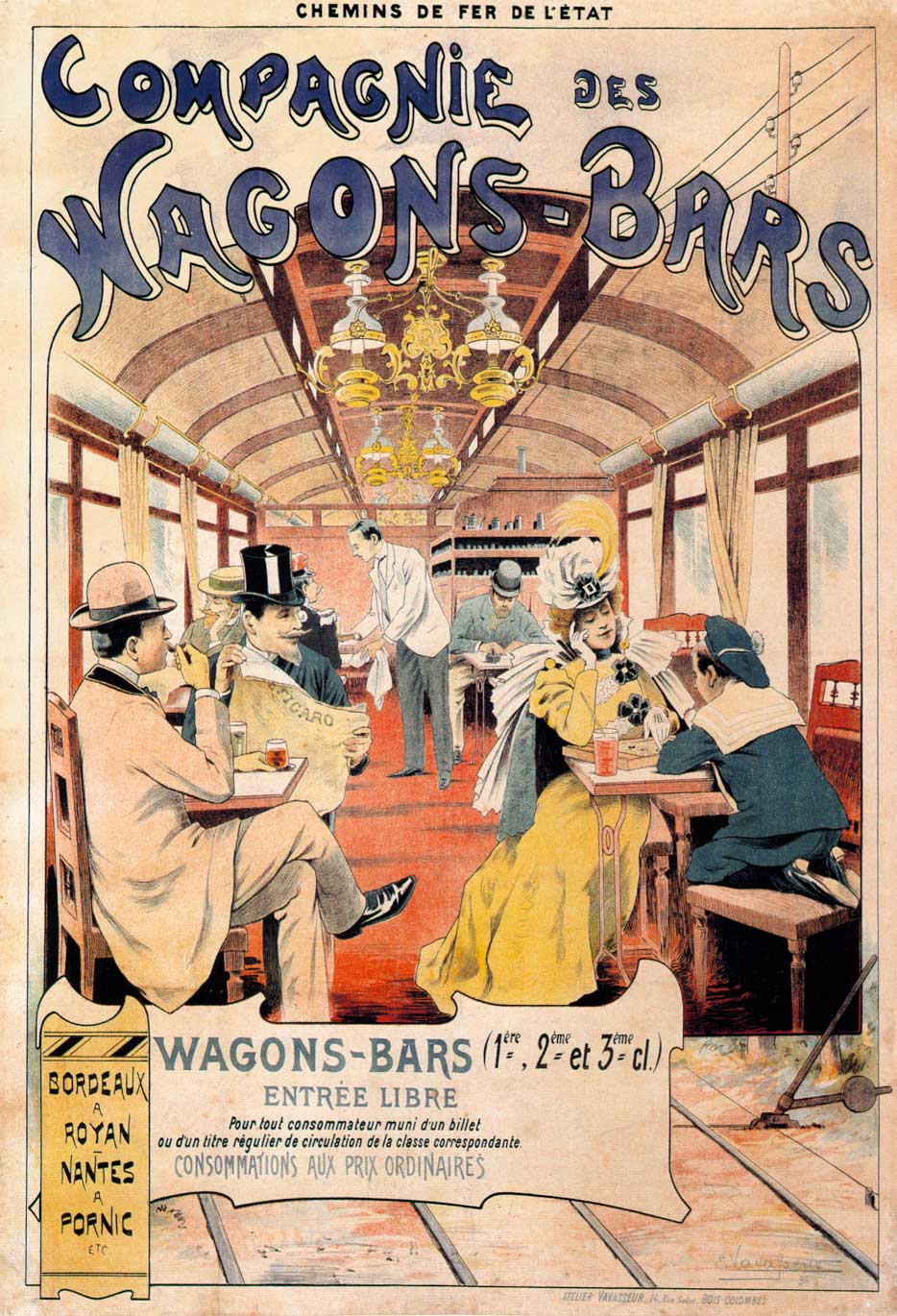
After a test drive between Paris and Saint-Germain-en-Laye, the Compagnie des Wagons-Bars was founded in 1896. In addition to the Chemins de Fer de l'Ouest railways west of Paris, the bar cars also ran on the Chemins de fer de l'État lines from Bordeaux and Nantes to the Atlantic coast. In 1898 the company name was changed to Compagnie Française des Wagons-Buffets. When the company ran into financial problems after the turn of the century, it wanted to expand to other regions, but this was strongly opposed by Wagons-Lits. This major competitor purchased the majority of shares in 1902. The company continued to operate independently until 1914, distinguishing itself from Wagons-Lits with third-class diners, without tablecloths!
Mitropa
Mitropa was founded by the end of the First World War. Germany wanted to break the monopoly of Wagons-Lits, the Belgian-French sleeping and dining car company. A Central European counterpart was established with confiscated Wagons-Lits cars and a mishmash of German sleeping and dining cars. After the German defeat, Mitropa's market was restricted to Germany, Austria and their northern neighbors. In the early 1920s Mitropa replaced the old rolling stock by steel carriages. In 1929 manufacturer Wegmann supplied 35 more new dining cars. They consisted of a modern electric kitchen and a smoking section with 18 seats, separated by a glass wall from the dining room with space for 34 non-smokers. The interior was straight and functional, but had a luxurious finish.
Thirst, hunger and boredom do not exist in a Mitropa dining car, the text on a brown-toned poster from around 1935 claimed. It is unknown which designer was behind the M.O. initials. Mitropa also served coffee and small refreshments in the railway coaches of the Deutsche Reichsbahn, as shown on a textless poster from a series called Die schöne Eisenbahnreise by the then renowned designer Bernd Reuters.
Dine well by LNER
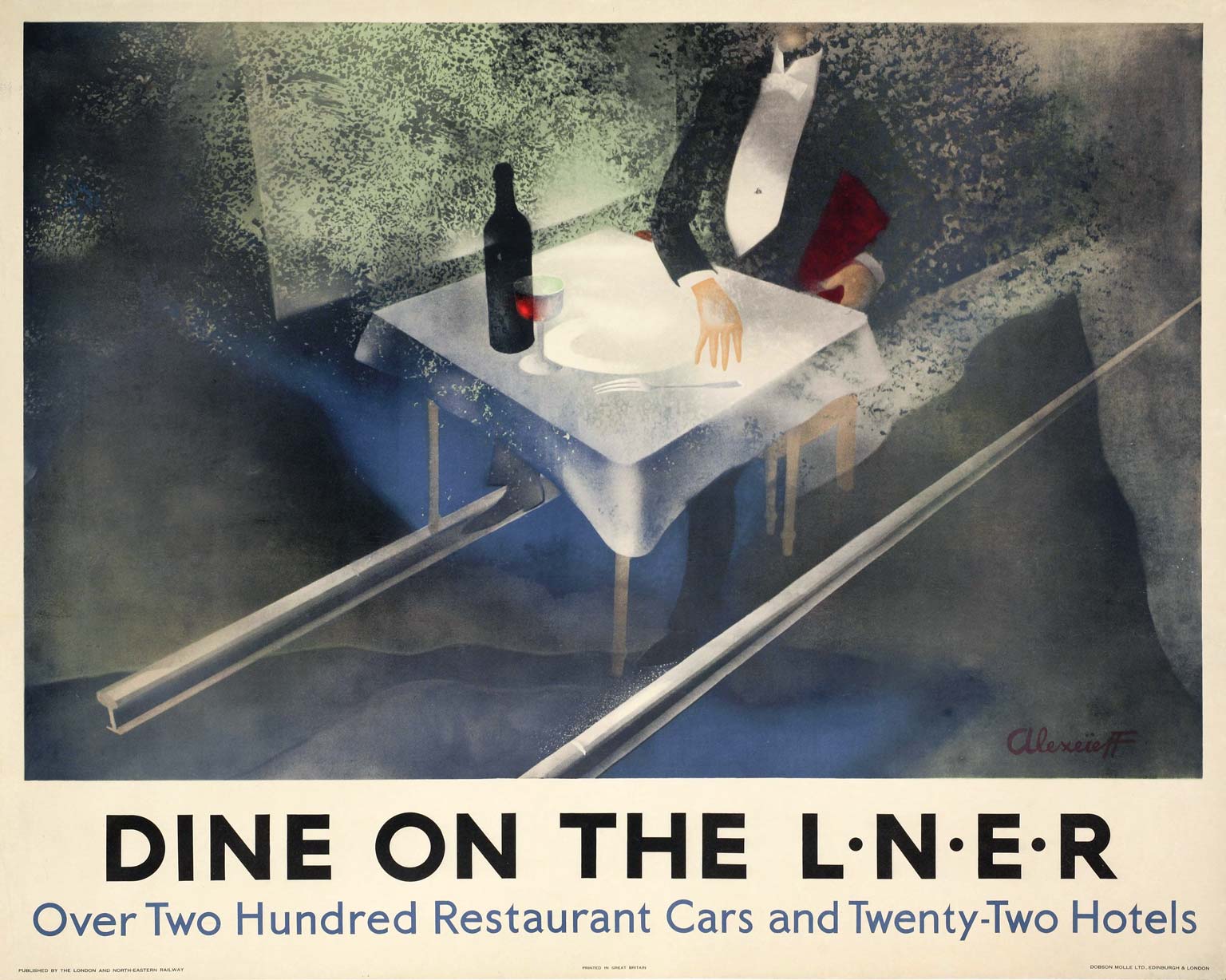
The London and North Eastern Railway (LNER) had over 200 restaurant cars in 1928, as can be read on a poster from that year, showing a set table on rails. It was created by the Russian-born illustrator and filmmaker Alexandre Alexeïeff. LNER's flagship was The Flying Scotsman, a fast train from London King's Cross to Edinburgh. Three coupled dining cars provided room for 78 guests in different classes. First-class passengers were seated on freestanding chairs at set tables. In the modern and compact galley, all kitchen equipment was fully electrical. The current was supplied by a dynamo driven by a coach axle.The use of electricity was safer and more hygienic than on-board gas tanks.
According to a newspaper report, an extensive lunch in The Flying Scotsman consisted of, for example: Potage Albion, Boiled Cod and Parsley Sauce, Roast Leg of Mutton and Jelly or Pressed Beef, York Ham, Chicken and Ham. Mixed Salad. Potatoes, Beans, Peas, Marrow. Sultana Pudding or Stewed Plums and Custard. Cheese. Biscuits. Coffee.
A set of two posters by Austin Cooper from 1933 made clear that LNER passengers could expect excellent service: perfection — 'and nothing less' — from the chefs preparing the meals, as well as discretion from the waiters providing the guests with drinks and cigars.
Wagon-Bar

On The Flying Scotsman passengers could not only relax in the restaurant during the 7-hour journey, but from 1932 onwards they could also pass time in a cocktail bar. The modern semicircular bar was constructed of light and glossy materials. A selection of 32 different cocktails was available. The signature cocktail Flying Scotsman consisted of whisky, vermouth, Angostura bitters, sugar syrup and ice. It was developed by Harry Craddock, the bartender of the Savoy Hotel in London. The cocktail bar was featured on a poster by photographer and designer Maurice Beck (1886-1960). The striking dark design evokes associations with nightlife, even though the train ran during daytime.

Bar cars were fashionable in the early 1930s. In France, Wagons-Lits introduced wagons-bars as an alternative to dining cars on the large railways that would merge into the national SNCF a few years later. In addition to drinks, small refreshments such as sandwiches were available 'a peu de frais' (for little money). The great French poster designer A.M. Cassandre captured the characteristic elements in a collage: a bogie (truck) and wheel, a bottle of wine, glasses, a soda siphon and a baguette. The bogie was based on a photo and intentionally printed in halftone dots; the other parts were drawn.
Pullman Express
During the Interwar period, a network of luxury day trains was established between European cities. On the European continent British Pullman Car Company cars were operated by Wagons-Lits. The heavy steel carriages had a dark blue livery with a recognizable cream border around the windows. The interiors were characterized by mahogany inlays, chrome fixtures and lavish upholstery. The Pullman trains did not have separate dining cars. Lunch and dinner were served at the seats out of the well-equipped galley. First-class passengers were seated in club chairs at double tables. The second class had fixed seats at four-person tables. Posters contributed to the legendary image of the Pullmans.
From 1927 onwards the Londres-Vichy Pullman Express took wealthy Britons from the port of Boulogne to the thermal baths of Vichy in central France. The Étoile du Nord connected Paris to Amsterdam. This day journey lasted about seven hours, 'du déjeuner au diner'. The Étoile du Nord became famous through an iconic poster by Cassandre. Remarkably, another Étoile du Nord poster in a much more traditional style appeared in 1927. While Cassandre was a master in representing speed and modernity, the other poster reflected the elegant atmosphere aboard. It showed a fashionable couple in Pullman seats at a table with a pink lamp. The poster can be attributed to William Spencer Bagdatopoulos (1888–1965). He was of Greek-British descent, but spent his childhood in The Netherlands.
De Pullman rijdt weer
International train services came to a standstill during the Second World War and railway infrastructure was severely damaged. It took some time before railway traffic fully resumed. In December 1945 the first post-war international train ran from Amsterdam to Brussels, equipped with the time-honored Pullman carriages. Fedde Weidema created a poster with familiar attributes of the Pullmans: a coffee cup with the Wagons-Lits logo, a silver pitcher and a pink table lamp. Weidema was explicitly asked to depict the cold-cut sandwiches. They were meant to represent abundance after the war shortages, but look rather scanty compared to the pre-war multi-course lunches.
The Pullman train had to make a detour of 80 kilometers because of the devastated Moerdijk bridge over the Hollands Diep, the principal North-South connection. It wasn't until May 1946 that the first train could cross it again. The Pullman train could then resume its old route to Paris as Étoile du Nord. On this occasion the Dutch railways (NS) published a poster titled 'Paris by Pullman' by Arthur Goldsteen (1908-1985). It shows a bistro table in front of a run-down but very romantic café in Paris. The chair is left invitingly empty. 'It attracts so much attention and arouses the desire to travel to the City of Lights, by Pullman or any other means', Dutch advertising magazine Ariadne wrote about the poster.
Buffets Gastronomiques

In 1948 Vincent Bourrel (1900-1981) became the General Secretary of the SNCF (French National Railways). He was also president of the Académie des gastronomes. At Bourrel's initiative the SNCF established a partnership with the tenants of 63 station buffets in regional towns all over France, called Buffets gastronomiques. They served a menu of starters, fish, meat garni, cheese and dessert at a fixed price, wine and service included. The dishes were prepared according to traditional regional recipes. In Nantes, for example, the buffet featured 'Civelles de Loire' and 'Coquilles Saint-Jacques à la Nantaise', while at La Rochelle 'Mouclade Rochelaise' was one of the specials. It was a way of luring Parisians as well as foreign tourists to travel the regions by train.
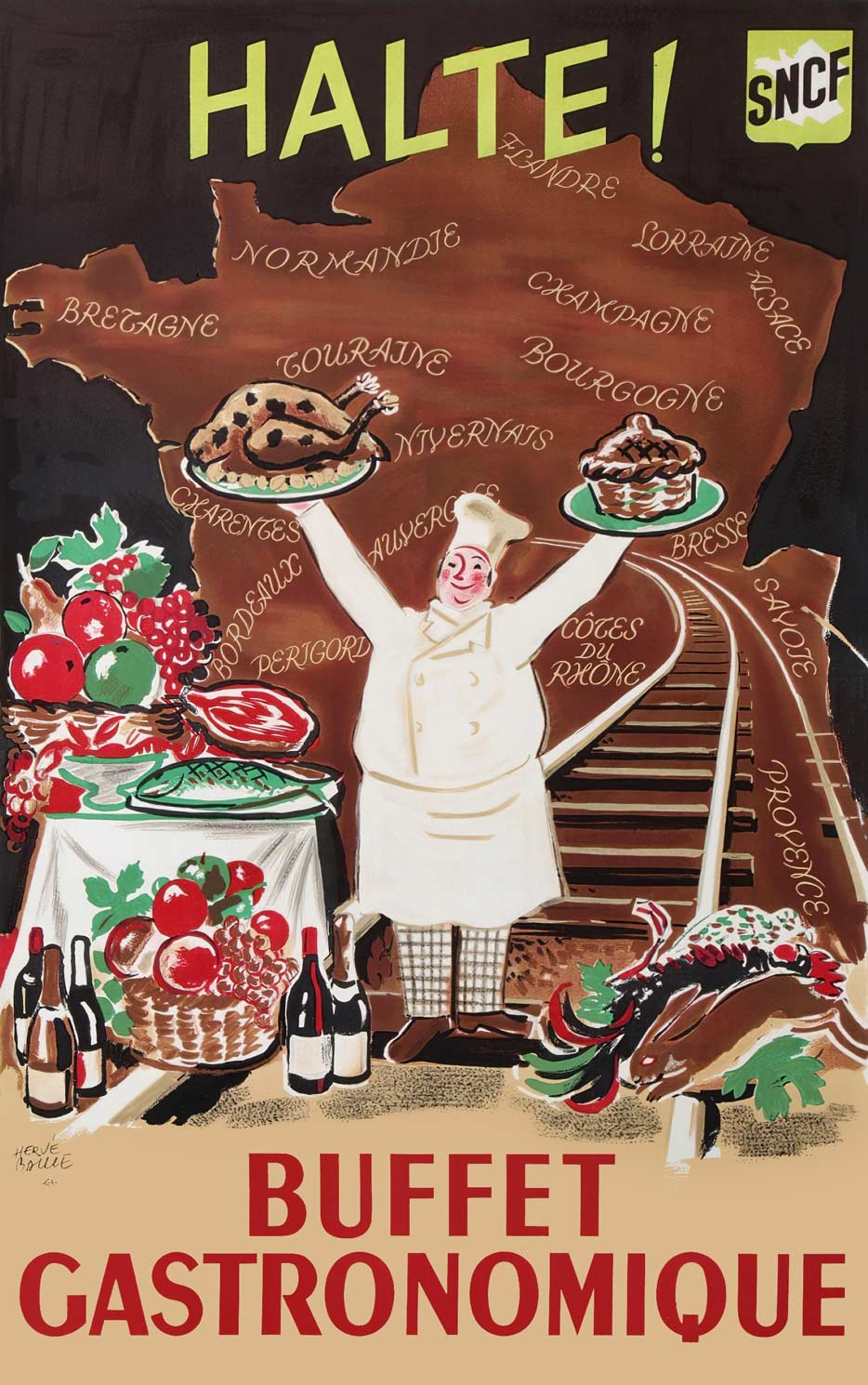
Two posters to promote culinary railway tourism were issued in 1950. The first one holds an interesting combination of modern and traditional elements. The shield-shaped sign with curly lettering refers to traditional taverns, while the seating is more in American Diner-style. The poster was designed by Pierre Baudouin (1921-1970), who mostly worked as a tapestry maker. The poster by illustrator and cartoonist Hervé Baille (1896-1974) was less subtle. It shows a chubby cook on a railway track surrounded by fresh ingredients. A map of France and its many regions serves as a backdrop. The word Halte! calls for a tasty stopover at one of the station buffets.
Wagon-Restaurant
Before World War II Wagons-Lits had carried those who could afford it in great luxury around Europe. After the war many carriages had lost their shine and European society was becoming more egalitarian. Wagons-Lits reached out to a wider audience by introducing an affordable tourist class. A 1953 poster by the French designer Jean Don (1900-1985) shows a 'Wagon-Restaurant' with a very cheerful waiter in a characteristic white jacket. The equally joyful audience is looking at him as though he is performing a balancing act.
In the 1950s full meals with good wines were still served at set tables. This was accomplished by a seven-man brigade, with three of them working in the galley. Passengers could expect a meal prepared of fresh ingredients. These were cooled by blocks of ice that were replaced at major stations, where new food supplies were also provided. By 1960 Wagons-Lits started to diversify its outlets. A poster by Guy Georget (1911-1997) hoped you would 'Eat well in their restaurant-cars, buffets, bars and airport restaurants'.
Plaisir double
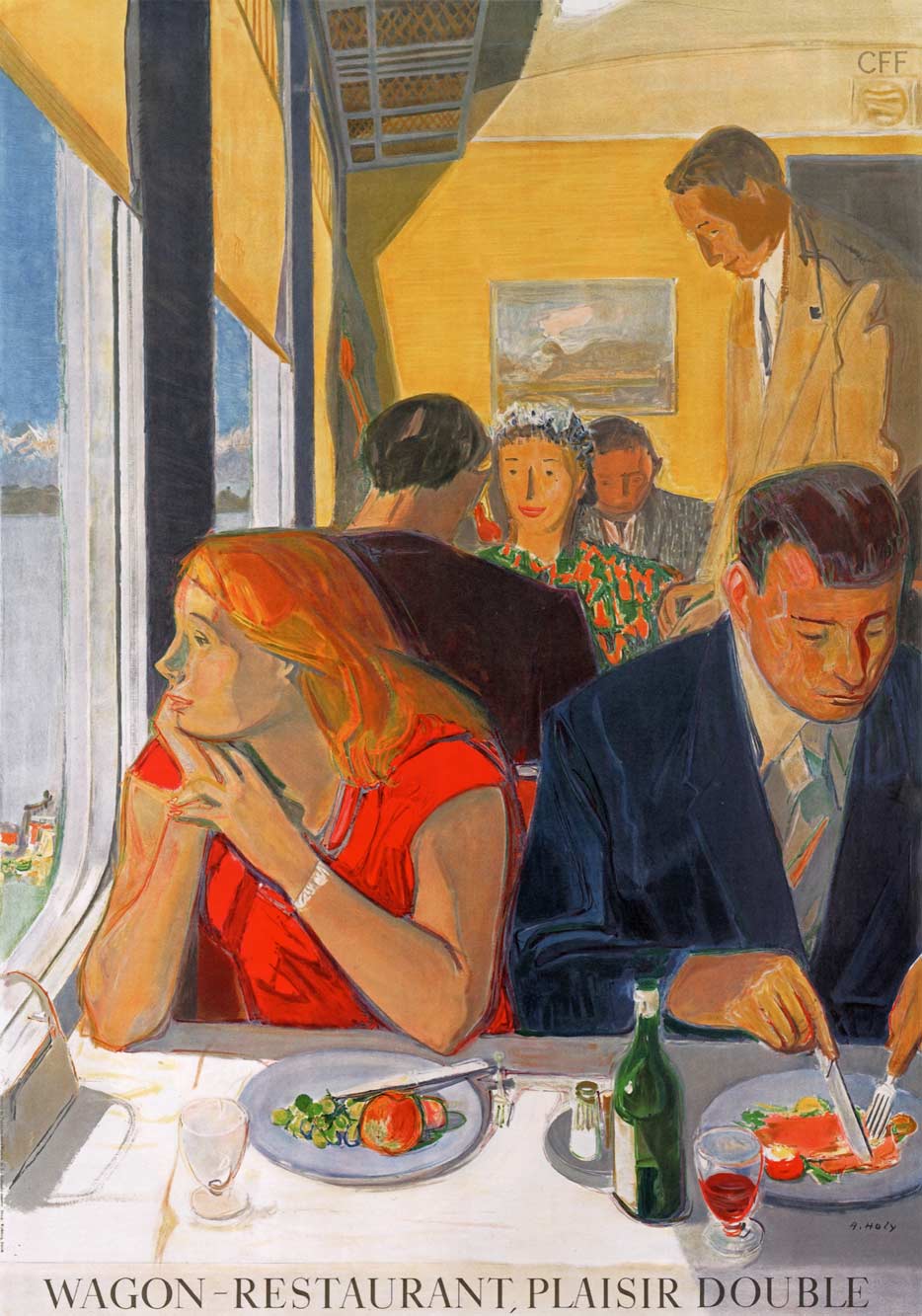
In the 1950s and 60s the Swiss Federal Railways (SBB) engaged well-known artists to provide the company with a new image of comfort and well-being. The poster by painter Adrien Holy (1898-1978) perfectly illustrates this message: the train allows for traveling while having a good meal at the same time, with the landscape as a moving backdrop. Doppeltes Vergnügen, it read on the German version: double the fun! Very sophisticated is the depiction of the lady, who is not busy with her plate or her partner as she would be in a standard advertising. Instead, she stares out the window and dreams away.
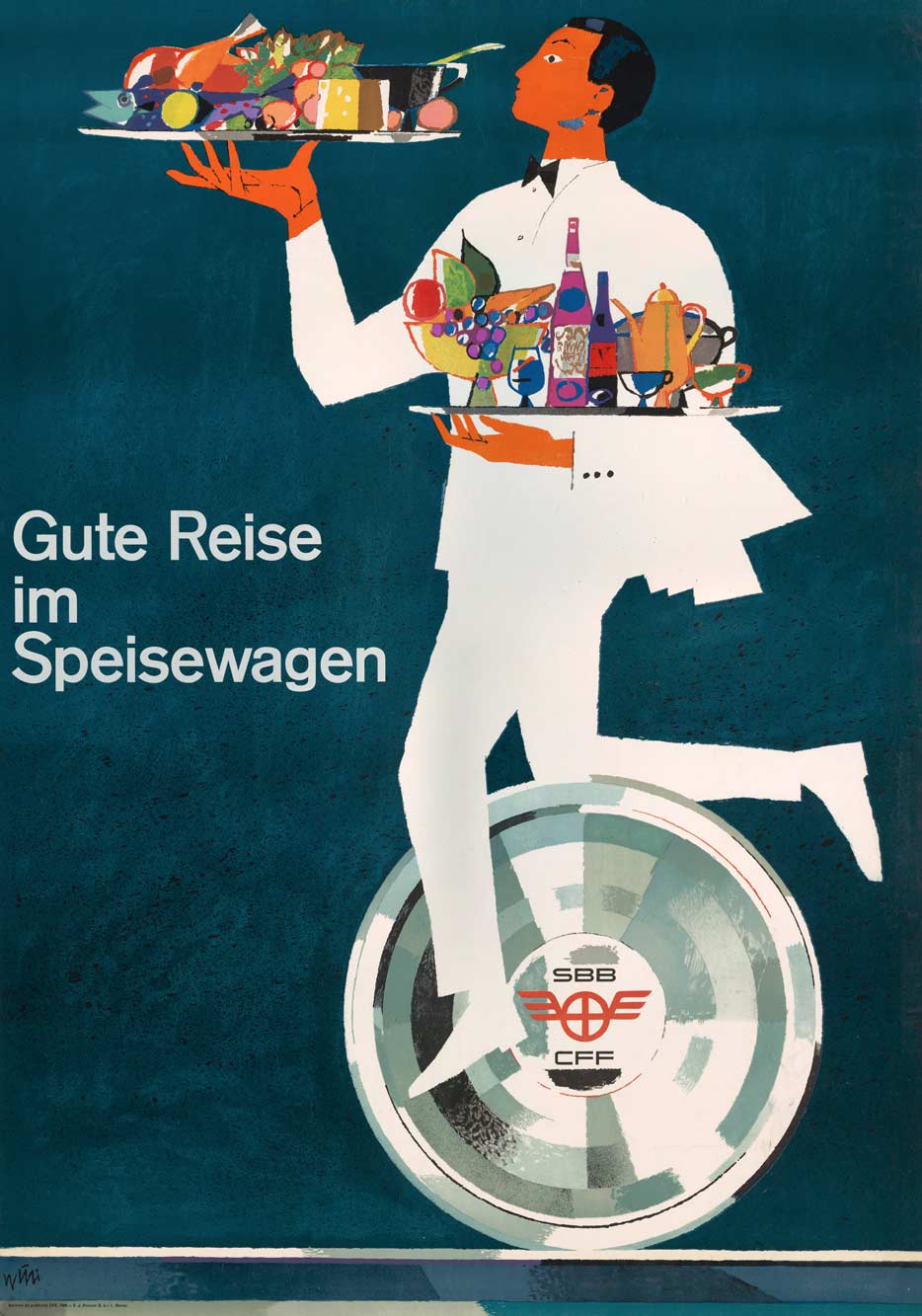
In 1960 Hugo Wetli, a contemporary of Holy, let an elegant waiter juggle on a winged wheel, the traditional symbol of the railways. On each hand he carries a tray full of food and drinks, a balancing act that every cafe visitor will recognize. It was one of the many light-hearted posters that were commissioned by Werner Belmont, SBB's successful marketing director. Under his leadership railway posters had become humorous and sometimes daring, providing the railways with a contemporary look.
Gril Express
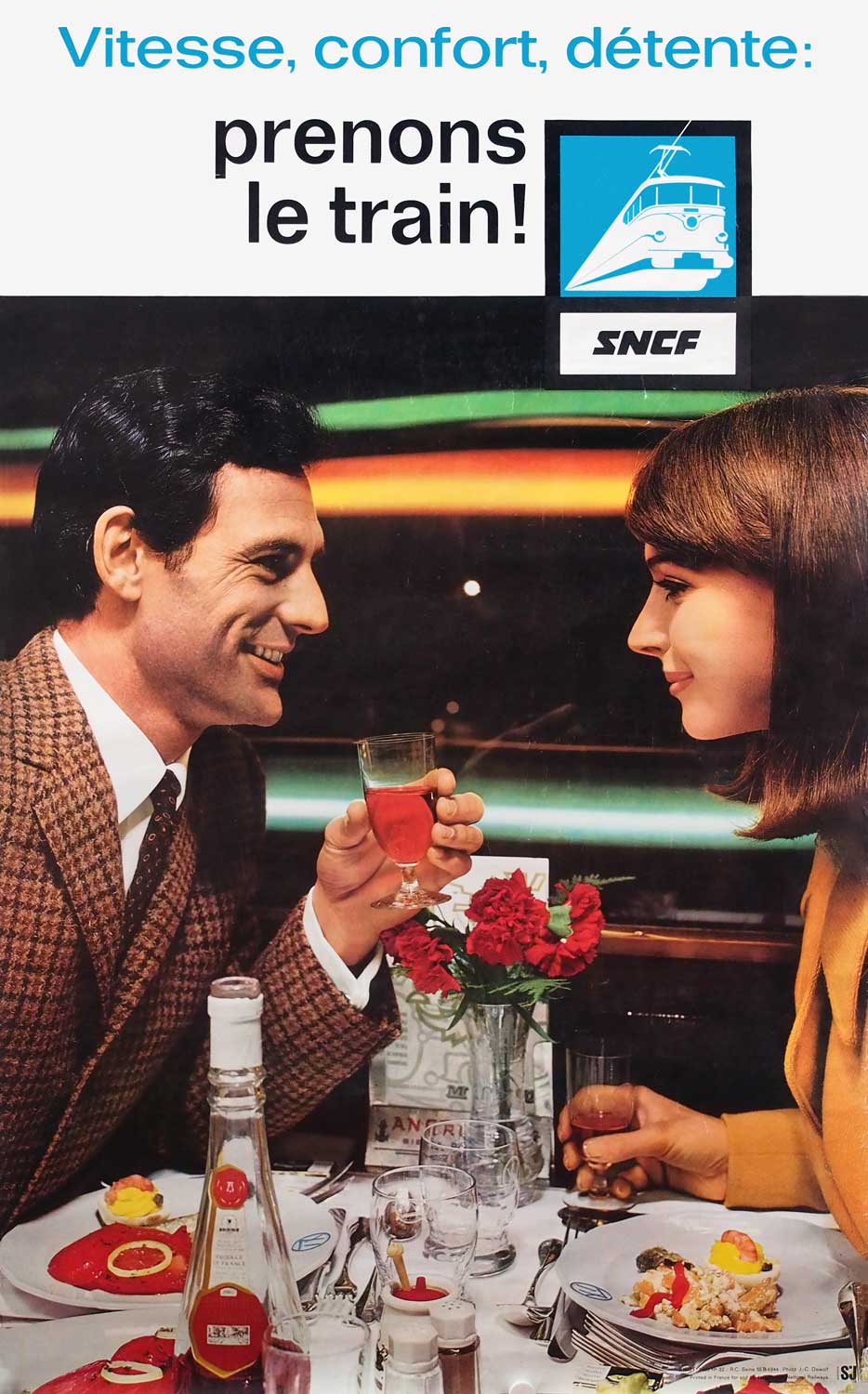
In 1962 the French SNCF acquired 114 dining cars from Wagons-Lits, which from then on would only supply staff. Between 1966 and 1968 a further 42 new dining cars were ordered. Nevertheless, classic restaurant cars no longer matched the spirit of the times, marked by democratization of travel. Fast-food made its appearance in the streets and self-service restaurants opened along highways. On busy railway services and holiday trains service at the seats was introduced. Like in airplanes, travelers were offered pre-prepared meals in plastic boxes on trays.
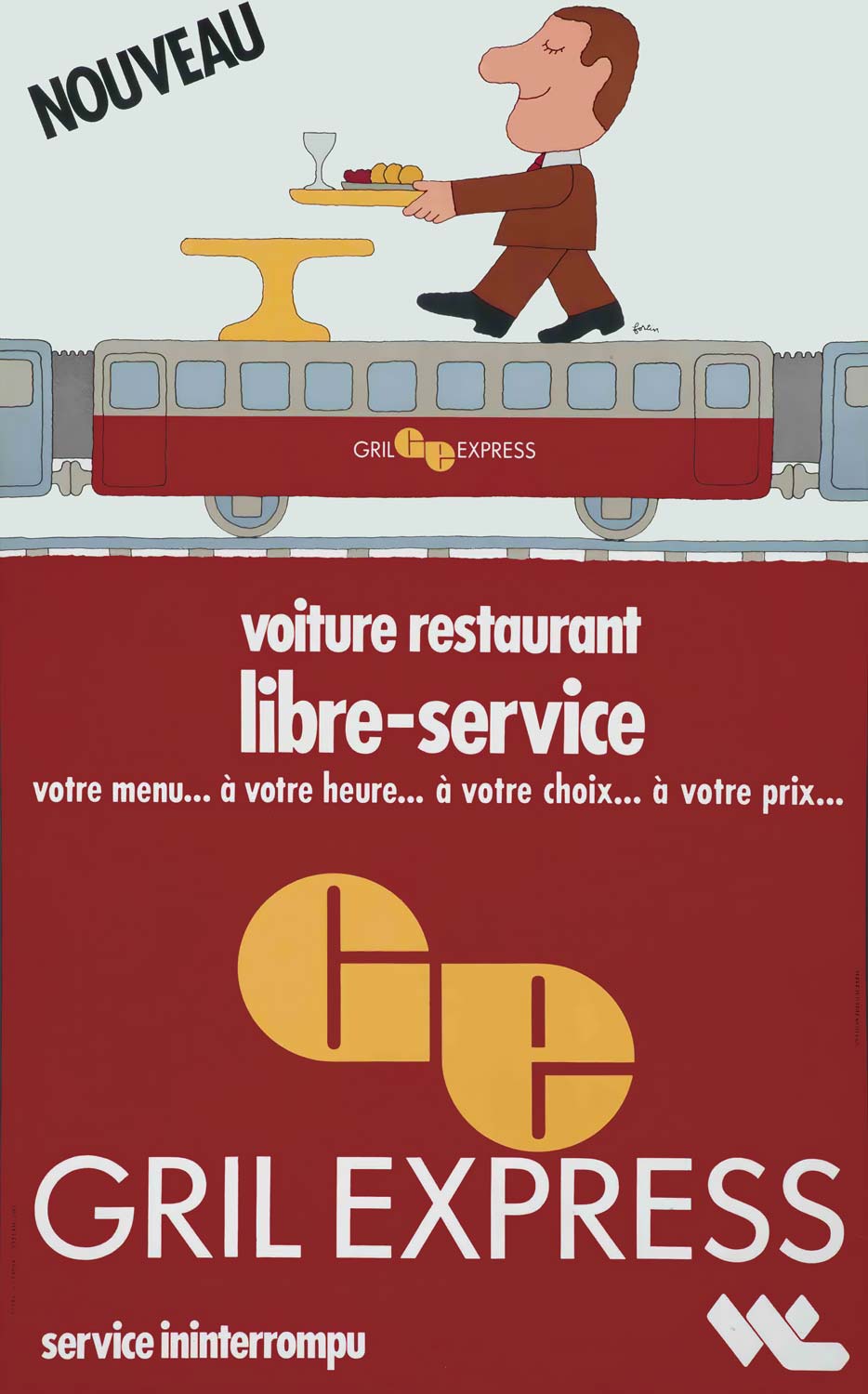
In 1963 a dining car was transformed into a self-service restaurant as a trial. Between 1967 and 1973 SNCF put 58 'mobile snack bars' into operation under the name Gril Express. Besides the kitchen and self-service buffet, they offered room for ten tables with four seats. Although efficient and cheap self-service was considered to be progress, there was still demand for 'real' dining cars, especially in luxury trains such as the Trans Europ Express (TEE). After 1980 these were mostly replaced by high-speed TGVs with a buffet compartment.
Restauratie = recreatie
In the 1970s the Belgian railways (SNCB) tried to improve the dull image of their restaurant cars and station buffets by issuing fresh posters. An abstracted illustration in green and blue showed a set table with wine, grapes, fish, an egg and sparkling water. The elements were placed diagonally for optimal dynamics. 'In our stations 20 restaurants and 84 buffets at your service', it told in modern Helvetica lettering. It was the preferred font of Louis Stryckman (1930-1910), who worked for the SNCB between 1970 and 1982. His graphic designs were strongly stylized with clean-cut lines.
In 1979 an equally fresh green poster advertised a 'new approach' of Belgian restaurant cars. This probably concerned a changed menu with a 'studied choice' and adjusted prices. 'Restoration [refreshment] = recreation', was the unexpected extra recommendation. The cartoonish image by an anonymous illustrator showed a chef stirring a saucepan while floating horizontally above the tracks. His chef's hat bears the logo of Wagons-Lits, which still provided the catering services in Belgian trains.
Venice-Simplon Orient Express
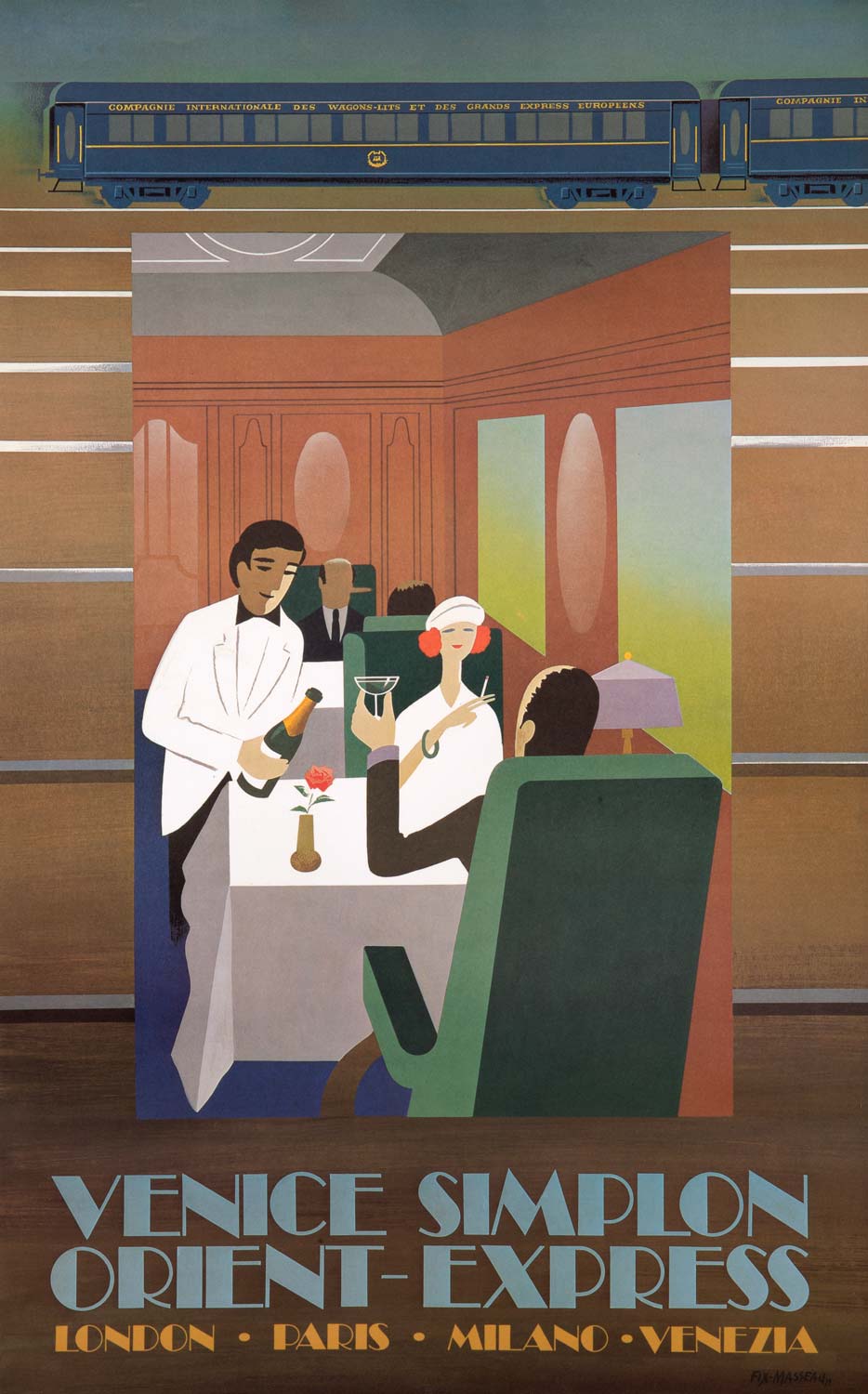
In 1977 the last direct train left Paris for Istanbul. Publicity about the (alleged) end of the Orient Express resulted in a revival. An American-British entrepreneur bought pre-war Wagons-Lits cars and had them restored for his Venice-Simplon Orient Express: a luxury 'rail cruise' between London, Paris and Venice. Once a year, the VSOE runs all the way to Istanbul. A refurbished parlor car with kitchen of the Étoile du Nord (Amsterdam-Paris) serves as a dining car. Service and food aboard are of star quality. Dining on the VSOE is more refined than it ever was on the real Orient Express.
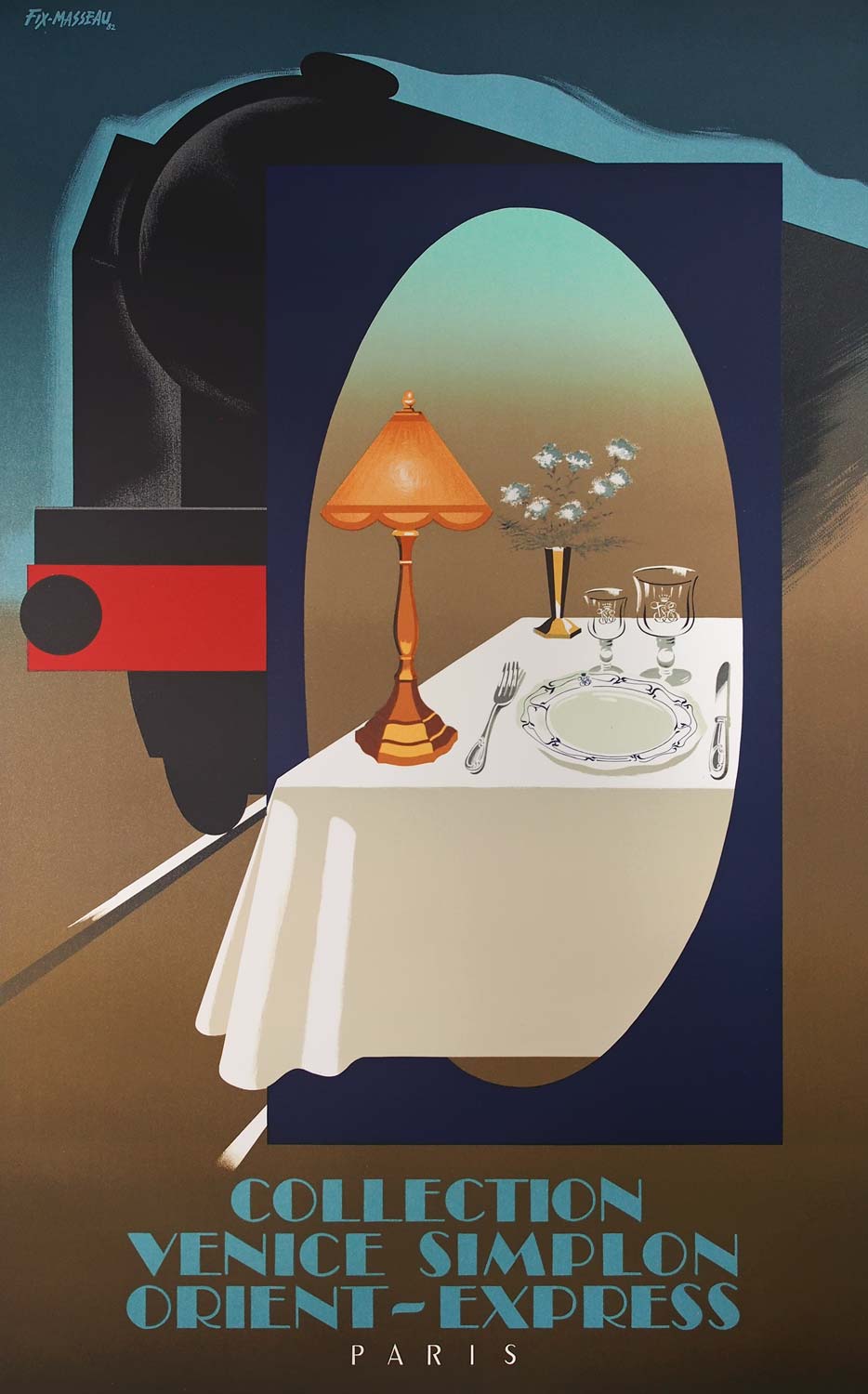
The VSOE inaugural menu of 1982 included expensive ingredients such as caviar, foie gras and lobster. The position of head chef is held by Christian Bodiguel since 1984. His signature dishes are Charolais beef with truffle caviar and roast salt-marsh lamb served with sage-flavoured polenta.
As the train had become retro, so did the posters. The VSOE engaged Pierre Fix-Masseau , a poster artist since 1928. He designed a series of Art Deco-style posters, but the fonts, colors and hairstyles reveal that they date from around 1980.
Travellers-Fare
Meanwhile, everyday train traffic was much more prosaic than in luxury nostalgia trains. In 1973 British Rail Catering, which operated the restaurant cars and station buffets, was renamed Travelers-Fare. Their hot 'full breakfast' aboard was very popular. Despite the fact that British Rail Sandwiches had a dubious reputation in popular culture, Travelers-Fare sold many millions of them each year. From 1976 onwards Travelers-Fare also catered the buffet in the InterCity 125, the 'high-speed train' that was iconic for the 1970s and 1980s.
In 1978 Travelers-Fare introduced the Gold Star Menu for business people on InterCity services. For around 5 pounds it offered a fixed four-course meal, which featured poached haddock and grilled salmon maître d'hôtel, for example. Second-class passengers were also welcome in the restaurant car, as a poster from the early 1980s shows. Like most posters in those years it was based on color photography. In 1986 on-board catering became the responsibility of InterCity, while Travelers-Fare focused on station buffets.
Het Station Restauraties
The station restaurants in the Netherlands were traditionally run by tenants. As in trains, they offered service in different classes. Besides simple cheese sandwiches, expensive dishes such as lobster were also on the menu. Around 1970 the restaurants at major stations were replaced by self-service restaurants run by Servex, a subsidiary of the Dutch railways (NS). The interiors were simple; paneled ceilings, movable planters and glass ball lamps created some atmosphere. The menu had also changed. The emphasis was on fast and affordable, with a special senior's offer and alternating monthly dishes like Cordon Bleu and Fish and Chips. In addition, the indistinct 'Honki Tonki' burger was introduced.
On the occasion of the 150th anniversary of Dutch railways in 1989, a restyling was implemented. All station restaurants were confusingly renamed 'Het Station' (The Station). The interiors were adapted: 'The comfortable atmosphere in the new restaurants of Het Station ensures a convenient and pleasant stay.' The food was slightly better, but the slogan 'a culinary trip for travelers' was not fulfilled. When the NS was privatized in 1995, station kiosks and fast-food counters became an important source of revenue. Around the turn of the century most station restaurants disappeared in favor of new 'concepts' such as Julia's pasta and Burger King. Still, some people hunger back to the traditional station restaurant: an unassuming place to unwind and enjoy a modest meal from a real plate.
